(完整版)《物理专业英语》
物理学专业英语讲义
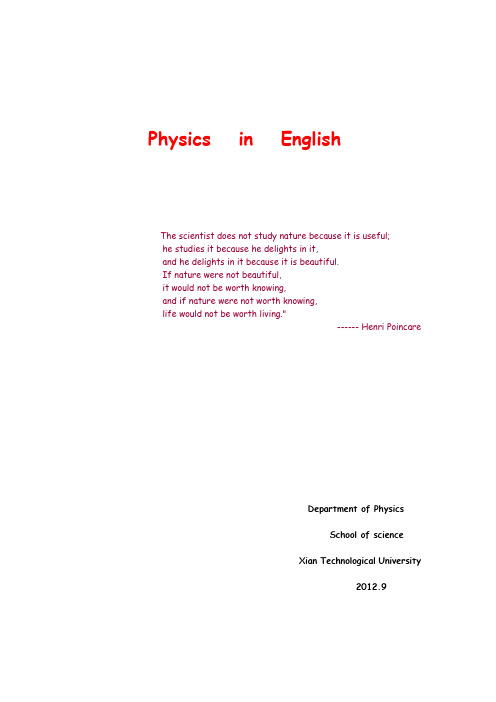
Physics in EnglishThe scientist does not study nature because it is useful;he studies it because he delights in it,and he delights in it because it is beautiful.If nature were not beautiful,it would not be worth knowing,and if nature were not worth knowing,life would not be worth living."------ Henri PoincareDepartment of PhysicsSchool of scienceXian Technological University 2012.9Chapter 1 What is Physics?Physics is natural science studying nature's LawsPhysics was called natural philosophy and fundamental science.The history of physicsThe history of physics encompasses two broad time periods in which classical physics and modern physics developed. Classical physics developed between 1600 and 1900. It embraces the general areas of physics known as mechanics, thermodynamics, and electromagnetism, culminating in relativity. Modern physics began developing between about 1890 and 1930, when it was realized that classical physics could not account for the newly discovered behavior of nature at the atomic and molecular level. Modern physics includes the theory of relativity as well as quantum mechanics and most of the subsequent new physics discovered and developed during the 20th century.Classical physicsClassical physics includes the traditional branches and topics that were recognized and well-developed before the beginning of the 20th century—classical mechanics, optics, thermodynamics, and electromagnetism. Classical mechanics is concerned with bodies acted on by forces and bodies in motion and may be divided into statics (study of the forces on a body or bodies at rest), kinematics (study of motion without regard to its causes), and dynamics (study of motion and the forces that affect it); Acoustics, the study of sound, is often considered a branch of mechanics because sound is due to the motions of the particles of air or other medium through which sound waves can travel and thus can be explained in terms of the laws of mechanics. Among the important modern branches of acoustics is ultrasonics, the study of sound waves of very high frequency beyond the range of human hearing. Optics, the study of light, is concerned not only with visible light but also with infrared and ultraviolet radiation, which exhibit all of the phenomena of visible light except visibility, e.g., reflection, refraction, interference, diffraction, dispersion, and polarization of light. Heat is a form of energy, the internal energy possessed by the particles of which a substance is composed; thermodynamics deals with the relationships between heat and other forms of energy. Electricity and magnetism have been studied as a single branch of physics since the intimate connection between them was discovered in the early 19th century; an electric current gives rise to a magnetic field and a changing magnetic field induces an electric current. Electrostatics deals with electric charges at rest, electrodynamics with moving charges, and magnetostatics with magnetic poles at restThe Emergence of Classical PhysicsClassical mechanics has its roots in the work of Johannes Kepler, who, between 1600 and 1619, became the first person to describe quantitatively and accurately the elliptic paths of the planets around the Sun.The problem of the shape of the planetary orbits was not easy to solve, because all historical observations of the planets were made from the Earth, itself a moving planet. Although a crude heliocentric(Sun-centered) model of the solar system using circular orbits was proposed by the Greek astronomer Aristarchus in the third century B.C. and resurrected by Copernicus in 1542,the planetary positions predicted by Copernicus were not as accurate as those found using Ptolemy's complicated geocentric (Earth-centered} model of the second century A.D.The pure Copernican model was inaccurate because Copernicus refused to abandon the flawed concept of early Greek thought that the natural path of a moving "perfect" celestial object, such as a planet, had to be in the shape of the "perfect" geometrical figure---a circle---with the planet moving at constant speed. a scientist living at the time of Copernicus would have been forced to reject the Copernican theory with its circular planetary orbits, since they did not account for the observed motions of the planets as accurately as the existing, but more complicated, geocentric theory of Ptolemy.The change from the accurate but complex Ptolemaic geocentric model of the solar system to the accurate and simple heliocentric model of Kepler illustrates the characteristics of a good theory. With Kepler's work, accuracy and simplicity blossomed simultaneously from the heliocentric hypothesis. Kepler's model and mathematical methods began the development of physics as we know it. His work was a watershed of quantitative thought and a new worldview.Observation of nature and experimental results typically precede the general theories that account for them. The extensive observations of the planets by Tycho Brahe just prior to 1600 provided Kepler with the data he needed to model the solar system accurately and precisely。
物理专业英语
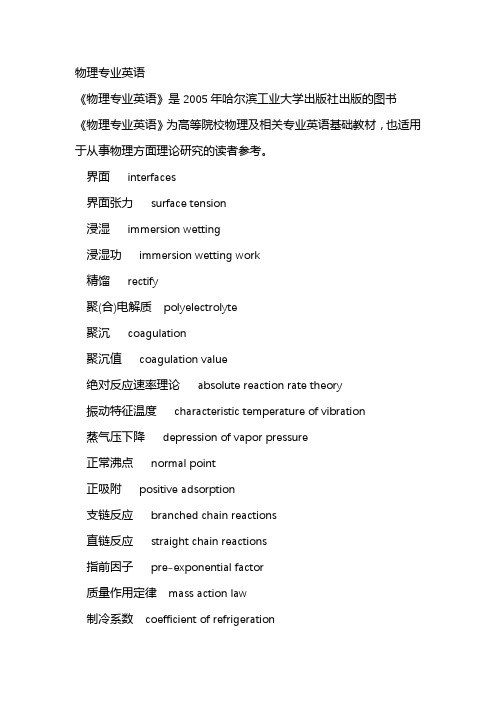
物理专业英语《物理专业英语》是2005年哈尔滨工业大学出版社出版的图书《物理专业英语》为高等院校物理及相关专业英语基础教材,也适用于从事物理方面理论研究的读者参考。
界面interfaces界面张力surface tension浸湿immersion wetting浸湿功immersion wetting work精馏rectify聚(合)电解质polyelectrolyte聚沉coagulation聚沉值coagulation value绝对反应速率理论absolute reaction rate theory振动特征温度characteristic temperature of vibration蒸气压下降depression of vapor pressure正常沸点normal point正吸附positive adsorption支链反应branched chain reactions直链反应straight chain reactions指前因子pre-exponential factor质量作用定律mass action law制冷系数coefficient of refrigeration中和热heat of neutralization阿伏加德罗常数Avogadro'number阿伏加德罗定律Avogadro law阿累尼乌斯电离理论Arrhenius ionization theory阿累尼乌斯方程Arrhenius equation阿累尼乌斯活化能Arrhenius activation energy阿马格定律Amagat law艾林方程Erying equation爱因斯坦光化当量定律Einstein's law of photochemical equivalence爱因斯坦-斯托克斯方程Einstein-Stokes equation安托万常数Antoine constant安托万方程Antoine equation盎萨格电导理论Onsager's theory of conductance半电池half cell半衰期half time period饱和液体saturated liquids饱和蒸气saturated vapor饱和吸附量saturated extent of adsorption饱和蒸气压saturated vapor pressure爆炸界限explosion limits比表面功specific surface work比表面吉布斯函数specific surface Gibbs function比浓粘度reduced viscosity标准电动势standard electromotive force标准电极电势standard electrode potential标准摩尔反应焓standard molar reaction enthalpy标准摩尔反应吉布斯函数standard Gibbs function of molar reaction标准摩尔反应熵standard molar reaction entropy标准摩尔焓函数standard molar enthalpy function标准摩尔吉布斯自由能函数standard molar Gibbs free energy function标准摩尔燃烧焓standard molar combustion enthalpy标准摩尔熵standard molar entropy标准摩尔生成焓standard molar formation enthalpy标准摩尔生成吉布斯函数standard molar formation Gibbs function标准平衡常数standard equilibrium constant标准氢电极standard hydrogen electrode标准态standard state标准熵standard entropy标准压力standard pressure标准状况standard condition表观活化能apparent activation energy表观摩尔质量apparent molecular weight表观迁移数apparent transference number 表面surfaces表面过程控制surface process control表面活性剂surfactants表面吸附量surface excess表面张力surface tension表面质量作用定律surface mass action law。
(完整版)高中物理专业英语词汇

一、机械运动机械运动mechanical motion [mi'k?nik?l] ['m?u??n]力学mechanics [m?'k?n?ks]质点mass point [m?s] [p?int]参考系reference frame ['refr?ns] [freim]坐标系coordinate system [k?u'?:dineit] ['sist?m]路程path[pɑ:θ]位移displacement[d?s'ple?sm?nt]矢量vector['vekt?]标量scalar['skeil?]速度velocity[vi'l?siti]平均速度average velocity['?v?rid?] [vi'l?siti瞬时速度instantaneous velocity[,?nst?n'teinj?s]速率speed[spi:d]v-t 图象v-t graph[ɡrɑ:f]加速度acceleration [?k,sel?'re???n]匀变速直线运动uniform variable rectilinear motion['ju:nif?:m] ['v??ri?bl] [,rekti'lini?]初速度initial velocity[i'ni??l] [vi'l?siti]自由落体运动free-fall motion自由落体加速free-fall acceleration[?k,sel?'re???n]重力加速度gravitational acceleration [,ɡr?vi'tei?n?l]二、物体的相互作用力force[f?:s]牛顿Newton['nju:tn]重力gravity['ɡr?viti]重心center of gravity['sent?]万有引力gravitation[,gr?v?'te???n]电磁相互electromagnetic interaction[?,lektr??m?g'net?k]强相互作用strong interaction[,?nt?r'?k??n]弱相互作用weak interaction形变deformation[,di:f?:'me???n,]弹性形变elastic deformation[i'l?stik] [,di:f?:'me???n,]弹性限度elastic limit[i'l?stik] ['limit]弹力elastic force[i'l?stik] [f?:s]劲度系数coefficient of stiffness[,k???'f???nt] ['st?fn?s]胡克定律Hooke law[l?:]摩擦力friction force['frik??n]静摩擦力static frictional force['st?tik] ['frik??n]滑动摩擦力sliding frictional force['slaidi?]动摩擦因数dynamic friction factor[dai'n?mik]合力resultant force[ri'z?lt?nt]分力component force[k?m'p?un?nt]力的合成composition of forces[,k?mp?'zi??n]平行四边形定则parallelogram rule[,p?r?'lel?,gr?m]共点力concurrent forces[k?n'k?:r?nt,]力的分解resolution of force[,rez?'lu:??n]三角形定则triangular rule[tra?'??gj?l?] [ru:l]三、牛顿运动定律运动学kinematics[kini'm?tiks]动力学dynamics[dai'n?miks]牛顿第一定律Newton first law['nju:tn] [l?:]惯性inertia [i'n?:?j?]惯性定律law of inertia[i'n?:?j?]质量mass[m?s]惯性系inertial system['sist?m]牛顿第二定律Newton second law单位制system of units国际单位制Le System International d’Unites作用力action['?k??n]反作用力reaction[ri'?k??n]牛顿第三定律Newton third law超重overweight[,??v?'we?t]失重weightlessness['we?tl?s]误差error['er?]偶然误差accidental error[,?ksi'dentl]系统误差systematic error [,sist?'m?tik]绝对误差absolute error['?bs?lu:t]相对误差relative error['rel?tiv]四、圆周运动曲线运动curvilinear motion[k?:vi'lini?]切线tangent['t?nd??nt]抛体运动projectile motion[pr?'d?ekt?l,]抛物线parabola[p?'r?b?l?]线速度linear velocity['lini?]匀速圆周运动uniform circular motion['ju:nif?:m] ['s?:kjul?]角速度angular velocity['??gj?l?]弧度radian['reidj?n]周期period['pi?ri?d]向心加速度centripetal acceleration[sen'tr?p?tl]向心力centripetal force[sen'tr?p?tl]开普勒Kepler引力常量gravitational constant [,ɡr?vi'tei?n?l] ['k?nst?nt]万有引力定律law of universal gravitation[,ju:ni'v?:s?l]第一宇宙速度first cosmic velocity['k?zmik]第二宇宙速度second cosmic velocity第三宇宙速度third cosmic velocity黑洞black hole五、能量能量energy['en?d?i]势能potential energy[p?'ten??l]动能kinetic energy[k?'net?k, ka?-]功work[w?:k]焦耳joule[d?u:l]功率power['pau?]瓦特watt['pau?]重力势能gravitational potential energy [,ɡr?vi'tei?n?l] [p?'ten??l]弹性势能elastic potential energy[i'l?stik] [p?'ten??l]动能定理theorem of kinetic energy['θi:?r?m] [k?'net?k]机械能mechanical energy[mi'k?nik?l]机械能守恒定律law of conservation of mechanical energy[,k?ns?'vei??n] [mi'k?nik?l]能量守恒定律law of energy conservation[,k?ns?'vei??n]拉力traction['tr?k??n]轨道obital大小magnatitude方向direction[di'rek??n]水平horizental竖直vertical['v?:tik?l]相互垂直perpendicular[,p?:p?n'd?kj?l?]坐标coordinate[k?u'?:dineit]直角坐标系cersian coordinate system弹簧spring[spri?]球体sphere[sfi?]环loop[lu:p]盘型disc圆柱形cylinder['silind?]。
物理专业英语
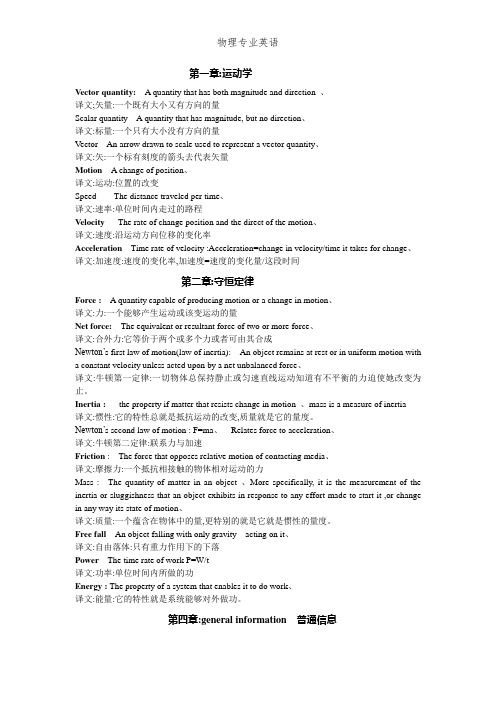
第一章:运动学Vector quantity: A quantity that has both magnitude and direction 、译文;矢量:一个既有大小又有方向的量Scalar quantity A quantity that has magnitude, but no direction、译文:标量:一个只有大小没有方向的量Vector An arrow drawn to scale used to represent a vector quantity、译文:矢:一个标有刻度的箭头去代表矢量Motion A change of position、译文:运动:位置的改变Speed The distance traveled per time、译文:速率:单位时间内走过的路程Velocity The rate of change position and the direct of the motion、译文:速度:沿运动方向位移的变化率Acceleration Time rate of velocity :Acceleration=change in velocity/time it takes for change、译文:加速度:速度的变化率,加速度=速度的变化量/这段时间第二章:守恒定律Force : A quantity capable of producing motion or a change in motion、译文:力:一个能够产生运动或该变运动的量Net force: The equivalent or resultant force of two or more force、译文:合外力:它等价于两个或多个力或者可由其合成Newton’s first law of motion(law of inertia): An object remains at rest or in uniform motion with a constant velocity unless acted upon by a net unbalanced force、译文:牛顿第一定律:一切物体总保持静止或匀速直线运动知道有不平衡的力迫使她改变为止。
物理专业英语课件
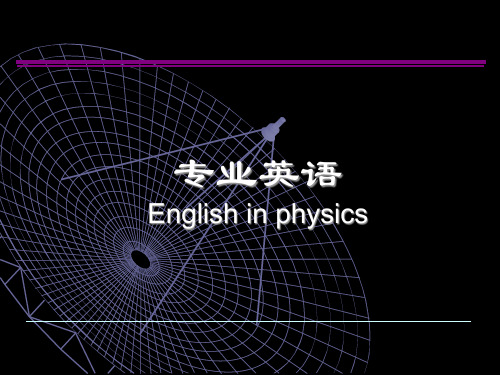
FRAME OF REFERENCE
The fact that if we choose different body as the reference to describe the same motion of a given object, the indications will be different, is called the relativity of the description and measurement of the motion, The particular body that serves as a reference chosen by the observer is defined as the frame of reference. It is usually pictured by means of a coordinate system, consisting three mutually perpendicular axes -X, -Y and Z-axes, and relative to it the position, velocity, acceleration and orbit of the moving object can be quantitatively specified. Particle is an ideal model used to simplify an object and to describe its motion. We can represent an object as a particle if every part of it moves in exactly the same way so that we can regard it as a mass point with no size and no shape. Translational motion -- the change of the position of the particle as a function of time will give a complete description of the motion for the given object.
物理专业英语
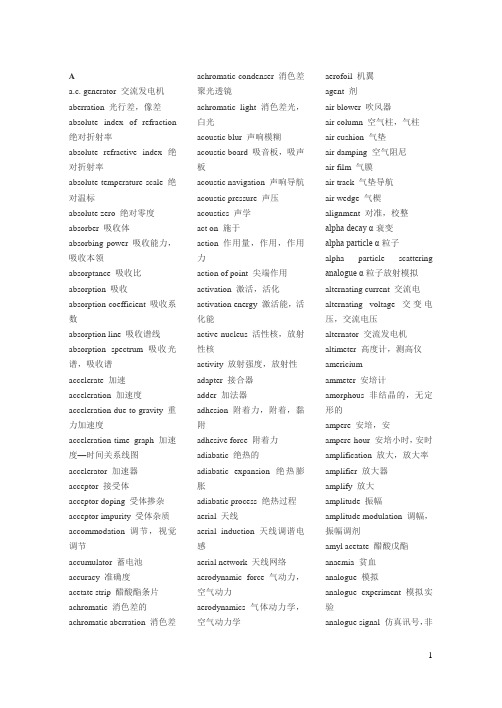
Aa.c. generator 交流发电机aberration 光行差,像差absolute index of refraction 绝对折射率absolute refractive index 绝对折射率absolute temperature scale 绝对温标absolute zero 绝对零度absorber 吸收体absorbing power 吸收能力,吸收本领absorptance 吸收比absorption 吸收absorption coefficient 吸收系数absorption line 吸收谱线 absorption spectrum 吸收光谱,吸收谱accelerate 加速acceleration 加速度acceleration due to gravity 重力加速度acceleration-time graph 加速度—时间关系线图accelerator 加速器acceptor 接受体acceptor doping 受体掺杂acceptor impurity 受体杂质accommodation 调节,视觉调节accumulator 蓄电池accuracy 准确度acetate strip 醋酸酯条片achromatic 消色差的achromatic aberration 消色差achromatic condenser 消色差聚光透镜achromatic light 消色差光,白光acoustic blur 声响模糊acoustic board 吸音板,吸声板acoustic navigation 声响导航acoustic pressure 声压acoustics 声学act on 施于action 作用量,作用,作用力action of point 尖端作用activation 激活,活化activation energy 激活能,活化能active nucleus 活性核,放射性核activity 放射强度,放射性adapter 接合器adder 加法器adhesion 附着力,附着,黏附adhesive force 附着力adiabatic 绝热的adiabatic expansion 绝热膨胀adiabatic process 绝热过程aerial 天线aerial induction 天线调谐电感aerial network 天线网络aerodynamic force 气动力,空气动力aerodynamics 气体动力学,空气动力学aerofoil 机翼agent 剂air blower 吹风器air column 空气柱,气柱air cushion 气垫air damping 空气阻尼air film 气膜air track 气垫导航air wedge 气楔alignment 对准,校整alpha decay α衰变alpha particle α粒子alpha particle scatteringanalogue α粒子放射模拟alternating current 交流电alternating voltage 交变电压,交流电压alternator 交流发电机altimeter 高度计,测高仪americiumammeter 安培计amorphous 非结晶的,无定形的ampere 安培,安ampere-hour 安培小时,安时amplification 放大,放大率amplifier 放大器amplify 放大amplitude 振幅amplitude modulation 调幅,振幅调剂amyl acetate 醋酸戊酯anaemia 贫血analogue 模拟analogue experiment 模拟实验analogue signal 仿真讯号,非数字讯号analogue-to-digital conversion 模拟转换analyser 检偏振器AND gate 「与」门anemometer 风速计aneroid barometer 无液气压计,空盒气压计angle of contact 接触角angle of deviation 偏向角angle of diffraction 衍射角,绕射角angle of dip 倾角angle of elevation 仰角angle of emergence 出射角angle of incidence 入射角angle of inclination 倾角angle of minimum deviation 最小偏向角angle of projection 投射角angle of reflection 反射角angle of refraction 折射角angle of twist 扭转角angstrom 埃angular acceleration 角加速度angular aperture 孔径张角angular displacement 角位移angular frequency 角频率angular impulse 角冲量angular magnification 角度放大,角放大率angular momentum 角动量,动量矩angular motion 角向运动,角运动angular seed 角速率angular velocity 角速度angular width 角宽度annealing 退火,韧化anode 阳极,正极anomalous expansion 反常膨胀antenna 天线anticlockwise moment 逆时针力矩antifreeze 防冻剂antinodal line 腹线antinode 波腹antiparticle 反粒子antiphase 反相,逆相aperture 孔径,口径,孔apparent depth 视深apparent expansion 表观膨胀,视膨胀apparent frequency 表观频率,视频率apparent loss in weight 表观失重apparent weight 表观重量Appleton layer 阿普顿层,F电离层aqueous layer 水层Archimedes' principle 阿基米得原理area 面积argon 氩armature 电枢artificial disintegration 人工蜕变artificial radioactivity 人工放射astable 非稳态的astable circuit 非稳态电路astable multivibrator 非态多谐振荡器astigmatism 像散,散光astronomical telescope 天文望远镜at infinity 在无穷远处at rest 静止atmosphere 大气,大气层,大气压atmospheric pressure 大气压强atom 原子atomic bomb 原子弹atomic bond 原子键atomic density 原子密度atomic diameter 原子直径atomic energy 原子能atomic mass 原子质量atomic mass unit 原子质量单位atomic model 原子模型atomic nucleus 原子核atomic number 原子序数atomic radius 原子半径atomic separation 原子间距atomic spacing 原子间距atomic structure 原子结构atomic theory 原子论atomizer 喷雾器attenuation 衰减attraction 吸引attractive force 吸力audible frequency range 听频范围audible signal 可听讯号audio frequency 声频autofocus 自动聚焦,自动对焦avalanche 电子雪崩average acceleration 平均加速度average power 平均功率average speed 平均速率average velocity 平均速度Avogadro constant 阿佛加德罗常数,阿佛加德罗常量Avogadro number 阿佛加德罗数Avogadro's law 阿佛加德罗定律axial 轴向的,沿轴的axial field 轴向场axial search coil 轴向探察线图axis 轴axis of rotation 转轴Bback e.m.f. 反电动势background radiation 本底辐射Bainbridge mass spectrometer 班布里奇质谱仪balance 天平,秤,平衡balance arm 秤杆,平衡臂balance point 平衡点balance bridge 平衡电桥balanced force 平衡力ball bearing 球轴承,滚珠轴承ballistic galvanometer 冲击电流计,冲击检流计ballistic pendulum 冲击摆Balmer series 巴耳末系,巴耳末光谱band spectrum 带状光谱,带状谱bandwidth 带宽bar code 条形码bar magnet 磁棒bare wire 裸线barium 钡barometer 气压计barrier 障碍物barrier layer 阻档层,耗尽层barrier potential difference 阻档层电势差,阻档层电位差Barton's pendulums 巴尔通摆base 基极base current 基极电流battery 电池组battery charger 电池充电器battery holder 电池座beaker 烧杯beam splitter 分束器,射束分离器beat 拍beat frequency 拍频becquerel 贝克勒耳,贝克bel 贝尔,贝bell jar 钟形罩bench mat 实验台垫Bernoulli's theorem 伯努利定律beryllium 铍beta decay β衰变beta particle β粒子biasing circuit 偏压电路biasing voltage 偏压biconcave lens 双凹透镜biconvex lens 双凸透镜bicycle dynamo 自行车发电机,脚踏车发电机bifilar pendulum 双线摆bifocal lens 双焦距透镜big bang model 大爆炸模型bimetallic strip 双层金属片,双金属片binary adder 二进加法器binary system 二进制binding 结合binding energy 结合能binoculars 双筒望远镜Biot-Savart law 毕奥—萨伐尔定律bipolar 双极的birefraction 双折射bistable 双稳态的,双稳器bistable circuit 双稳电路bistable multivibrator 双稳态多谐振荡器bit 二进制制,位black body radiation 黑体辐射block and tackle 滑轮组block diagram 方框图blocking capacitor 隔直流电器容blooming 敷霜,表面加膜Bohr atom 玻尔原子Bohr radius 玻尔半径Bohr theory 玻尔理论boil 沸腾,煮沸boiler 锅炉boiling point 沸点bolometer 辐射热计Boltzmann constant 玻耳兹曼常数,玻耳兹曼常量bombardment 轰击bond energy 键能bonding 键合Bourdon gauge 布尔登气压计bow wave 弓形波,舷波Boyle's law 博伊尔定律Brackett series 布喇开系,布喇开光谱Bragg angle 布喇格角Bragg diffraction 布喇格衍射,布喇格绕射Bragg plane 布喇格平面Bragg's law 布喇格定律brake 制动器breakdown potential 击穿电势,击穿电位breaking point 断点breaking strength 抗断强度breaking stress 致断应力breeder reactor 增殖反应堆bremsstrahlung 轫致辐射Brewster's law 布鲁斯特定律bridge circuit 桥式电路bridge rectifier 桥式整流器bright fringe 亮纹brightness 亮度brittle 脆的,易碎的bromine 溴Brownian movement 布朗运动brush 电刷bubble chamber 气泡室bubble raft model 泡筏模型buffer 缓冲器buffer circuit 缓冲电路bulk modulus 体积弹性模量Bunsen burner 本生灯buoyancy 浮力burette 滴定管burette stand 滴定管架burglar alarm 防盗警报器,防盗警钟buzzer 蜂鸣器by-pass 旁路byte 二进制组,字节Ccable 电缆cadmium sulphide 硫化镉caesium 铯calcite 方解石calibrate 校准,标上刻度calipers 测径器,卡钳calorie 卡路里,卡calorimeter 量热器camera 照相机cancer cell 癌细胞candela 坎德拉cantilever 悬臂capacitance 电容capacitance substitution box换值电容箱capacitive circuit 电容电路capacitive component 电容性分量capacitive coupling 电容耦合capacitive discharge 电容性放电capacitive reactance 容抗capacitor 电容器capacitor-input filter 电容输入滤波器capacity 容量,载量capillarity 毛细现象,毛细作用capillary depression 毛细下降capillary rise 毛细上升capillary tube 毛细管capsule 囊capture 俘获carbon 碳carbon granule 碳颗粒carbon paper disc 圆形碳纸carbon-14 dating 碳14年代测定法carburettor 化油器,汽化器carrier wave 载波carry 进位castor oil 蓖麻油cataract 白内障cathode 阴极,负极cathode ray 阴极射线cathode ray deflection tube阴极射线偏转管cathode-ray oscilloscope 阴极射线示波器,示波器cathode-ray tube 阴极射线管cavity resonator 空腔共振器celestial telescope 天体望远镜cell 电池,细胞Celsius temperature scale 摄氏温标centimetre 厘米centralized low voltage powersupply unit 中央控制低压电源箱centre of curvature 曲率中心centre of gravity 重心centre of mass 质心centre of oscillation 振荡中心centre-tapped transformer 中心抽头变压器centrifugal force 离心力centrifuge 离心机centripetal acceleration 向心加速度centripetal force 向心力Chadwick 查德威克chain reaction 连锁反应change of state 物态变化change-over switch 换向开关characteristic 特性,特征characteristic curve 特性曲线characteristic line 特征线,特征谱characteristic spectrum 特征光谱,特征谱charge 电荷,充电,起电charge carrier 载荷子charge conservation 电荷守恒charge density 电荷密度charge distribution 电荷分布charge to mass ratio 荷质比charged particle 带电粒子charging by contact 接触起电charging by friction 摩擦生电charging by induction 感应起电charging by sharing 授受起电charging time constant 充电时间常数,充电时间常量Charles's law 查理定律choke 扼流,抗流,扼流圈,抗流圈choke circuit 扼流电路,抗流电路chromatic aberration 色差chromatic dispersion 色散cinefilm soundtrack 电影胶片声迹circle of least confusion 最少模糊圈,明晰圈circuit 电路circuit board 电路板circuit breaker 断路器circuit symbol 电路符号circular coil 环形线圈circular motion 圆周运动circular orbit 圆周轨道circular pulse 圆形脉冲circular wave 圆形波circular wavefront 圆形波阵面,圆形波前clamp 夹钳,夹紧clap-echo method 「拍掌—回声」法cleave 裂开clinical thermometer 体温计clip 夹子clockwise moment 顺时针力矩closed circuit 闭合电路closed pipe 闭管closed tube 闭管closed-loop control system 死循环控制系统closed-loop gain 死循环增益closed-loop voltage gain 死循环电压增益closely packed 密堆积的cloud chamber 云室cloud chamber track 云室径迹coaxial 共轴,同轴coaxial cable 同轴电缆,同轴cobalt 钴code 编码coder 编码器coefficient of dynamic friction动摩擦系数coefficient of friction 摩擦系数coefficient of restitution 恢复系数coefficient of static friction静摩擦系数coefficient of viscosity 黏滞系数coherent 相干的cohesion 内聚力,内聚cohesive force 内聚力coil 线圈collector 集电极,集极collector current 集电极电流,集极电流collimator 准直管,准直仪collision 碰撞colour 颜色colour code 色码,色标combinational logic 组合逻辑common emitter 共发射极common-mode voltage 共模电压commutator 换向器compass 指南针,罗盘complete circuit 完整电路component 组件,分量,组分component of force 分力compound microscope 复式显微镜compound pendulum 复摆compressed gas 压缩气体compressibility 可压缩性,压缩系数,压缩率compressible fluid 可压缩性流体compression 密部,压缩compression spring balance 压缩弹簧天平concave 凹concave lens 凹透镜concave mirror 凹镜,凹面镜concentric capacitor 同心电容器condensation 凝结,凝聚condensation nucleus 凝结核,凝聚核condensation point 凝点,凝结点condenser 聚光器,电容器,冷凝器conductance 电导conductivity 传导性,传导率conductor 导体conical pendulum 锥摆conjugate foci 共轭焦点conservation of angularmomentum 角动量守恒conversation of charge 电荷守恒conservation of energy 能量守恒conservation of mechanicalenergy 机械能守恒conservation of momentum动量守恒conservative force 守恒力,保守力conserved 守恒constant acceleration 恒加速度constant angular acceleration恒角加速度constant angular velocity 恒角速度constant force 恒力constant motion 恒速运动constant pressure 定压constant speed 恒速率constant temperature 定温constant velocity 恒速度constant volume 定容constant volume gasthermometer 定容气体温度计constantan 康铜constriction 颈缩constructive interference 相长干涉contact angle 接触角contact area 接触面积contact force 接触力continuity equation 连续性方程continuous spectrum 连续光谱,连续谱continuous wave 连续波contract 收缩control experiment 对照实验,比对实验control grid 控制栅极control rod 控制棒control system 控制系统convection 对流converge 会聚converging lens 会聚透镜converging mirror 会聚镜convex 凸convex lens 凸透镜convex mirror 凸镜,凸面镜coolant 冷却剂cooling by evaporation 蒸发致冷cooling correction 冷却修正cooling curve 冷却曲线cooling effect 冷却效应cooling system 冷却系统,散热系统coplanar forces 共面力core 心,核心Coriolis force 科里奥利力corkscrew rule 螺旋法则cornea 角膜corona discharge 电晕放电corpuscular theory of light 光的微粒学说correction 矫正,修正cosmic radiation 宇宙辐射coulomb 库伦Coulomb's law 库伦定律count rate 计数率counter 计数器counter weight 平衡锤,配重couple 力偶coupled oscillation 耦合振荡coupling 耦合covalent bond 共价键crane magnet 起重磁铁creep 蠕变crest 波峰critical angle 临界角critical damping 临界阻尼critical mass 临界质量critical point 临界点critical temperature 临界温度critical velocity 临界速度crocodile clip 鳄鱼夹cross hairs 十字丝,叉丝cross-sectional area 截面积Crova's disc 克罗瓦盘crystal 晶体crystal diffraction 晶体衍射,晶体绕射crystal lattice 晶体点阵,晶体格子,晶格crystal planes 晶面crystalline 结晶的crystallization 结晶crystallography 晶体学cubical expansivity 体积膨胀系数,体积膨胀率curie 居里current 电流current amplification 电流放大current amplification factor电流放大因素current amplifier 电流放大器current balance 电流天平current density 电流密度current gain 电流增益current intensity 电流强度current pulse 电流脉冲current sensitivity 电流灵敏度current stabilizer 稳流器current transfer characteristic电流转移特性current-carrying conductor 载电流导体current-voltage characteristiccurve 电流—电压特性曲线curved mirror 曲面镜cyclotron 回旋加速器cylindrical concave lens 柱面凹透镜cylindrical concave mirror 柱面凹镜cylindrical convex lens 柱面凸透镜cylindrical convex mirror 柱面凸镜cylindrical lens 柱面透镜cylindrical mirror 柱面镜Dd.c. generator 直流发电机d.c. motor 直流电动机Dalton's law of partialpressures 道尔顿分压定律damped harmonic motion 阻尼谐动damped harmonic oscillation阻尼谐振damped oscillation 阻尼振荡damping 阻尼damping force 阻尼力dark fringe 暗纹data 数据dating 年代测定daughter nucleus 子核daughter nuclide 子核素de Broglie relation 德布罗意关系式de Broglie wave 德布罗意波dead time 失效时间decade capacitance box 十进电容箱decade resistance box 十进电阻箱decay 衰变decay analogue 衰变模拟decay constant 衰变常数,衰变常量decay curve 衰变曲线decay law 衰变定律decay product 衰变产物decelerate 减速deceleration 减速度decibel 分贝decode 译码,解碼decoder 译码器,译码器deflection 偏转deflection plate 偏转板deflection system 偏转系统deflection tube 偏转管deformation 形变degradation of energy 能量退降,能量递降degree 度degree Celsius 摄氏度degree of freedom 自由度demagnetization 去磁,退磁demonstration diode 演示用二极管demonstration meter 演示用电表density 密度depletion layer 耗尽层,阻挡层depth of field 景深derived quantity 导出量derived unit 导出单位destructive interference 相消干涉detection 探测detector 探测器detector of radiation 辐射探测器deuterium 氘,重氢deuteron 氘核,重氢核deviation 偏向,偏差device 装置,设计,器件diamagnetism 抗磁性diaphragm 光阑,膜片diatomic molecule 双原子分子dielectric 电介质,介电的dielectric constant 介电常数,介电常量,电容率dielectric polarization 电介质极化dielectric strength 电介质强度differential equation 微分方程differential input voltage 差动输入电压diffracted ray 衍射线,绕射线diffraction 衍射,绕射diffraction grating 衍射光栅,绕射光栅diffuse reflection 漫反射diffusion 扩散,漫射diffusion cloud chamber 扩散云室digital 数字的digital display 数字显示digital signal 数字讯号digital-to-analogue conversion数模转换dimension 量纲,因次,维,大小dimensional analysis 量纲分析,因次分析diminished 缩小diode 二极管diode probe 二极管微波探测器dioptre 屈光度,焦度dipole 偶极子direct current 直流电direction 方向,方位direction of propagation 传播方向directly heated cathode 直热式阴极discharge 放电disintegration 蜕变dislocation 位错dispersion 色散dispersive power 色散能力,色散本领,色散率displacement 位移,排量displacement can 排水罐displacement-time graph 位移—时间关系线图dissipative force 耗散力distance 距离distance-time graph 距离—时间关系线图distortion 失真,扭曲,畸变disturbance 干扰diverge 发散diverging lens 发散透镜diverging mirror 发散镜division of amplitude 振幅分割division of wavefront 波阵面分割,波前分割domain 畴,域domestic circuit 家居电路donor 给予体doped semiconductor 掺杂半导体doping 掺杂Doppler broadening 多普勒谱线增宽Doppler effect 多普勒效应Doppler shift 多普勒频移dosage 剂量dose 剂量dose rate 剂量率double pulley 双滑轮double refraction 双折射double slit 双缝double-pole-double-throw switch 双刀双掷开关doublet 双重线drag force 阻力,曳力drift velocity 漂移速度driver circuit 驱动电路driver frequency 驱动频率driving cell 驱动电池driving force 驱动力driving mirror 行车后视镜dry battery 干电池组dry cell 干电池dual trace oscilloscope 双迹示波器ductile 延性的Dulong-Petit law 杜隆—珀替定律dynamic equilibrium 动态平衡dynamic friction 动摩擦dynamic resistance 动态电阻dynamics 动力学dynamo 发电机Eearth 接地,地线 earthquake waves 地震波ebonite 硬橡胶,硬质胶ebonite rod 硬橡胶棒,硬质胶棒echo 回声,回波eddy current 涡电流,涡流eddy current damping 涡流阻尼eddy current loss 涡流损耗effective mass 有效质量efficiency 效率effort 施力Einstein's mass-energyrelation 爱因斯坦质能关系式elastic collision 弹性碰撞elastic constant 弹性常数,弹性常量elastic deformation 弹性形变elastic hysteresis 弹性滞后elastic limit 弹性极限elastic strain energy 弹性应变能elasticity 弹性electric bell 电铃electric charge 电荷electric current 电流electric field 电场electric field intensity 电场强度electric field pattern 电场图形electric fire 电暖炉electric line of force 电力线electric motor 电动机electric potential 电势,电位electric power 电功率electric shock 电震electrical appliance 电器electrical conductivity 导电率electrical energy 电能electrical oscillation 电振荡electrical potential energy 电势能,电位能electrical resonance 电共振electricity 电,电学electrode 电极electrolysis 电解electrolyte 电解质electrolytic 电解质的,电解的electrolytic capacitor 电解质电容器electromagnet 电磁铁,电磁体electromagnetic coil 电磁感应圈electromagnetic contact 电磁触点electromagnetic force 电磁力electromagnetic induction 电磁感应electromagnetic moment 电磁矩electromagnetic oscillation电磁振荡electromagnetic radiation 电磁辐射electromagnetic spectrum 电磁波谱electromagnetic wave 电磁波electromagnetism 电磁学electrometer 静电计electromotive force 电动势electron 电子electron beam 电子束electron cloud 电子云electron diffraction 电子衍射,电子绕射electron drift 电子漂移electron energy level 电子能级electron gun 电子枪electron transition 电子跃迁electron tube 电子管electron-volt 电子伏特,电子伏electronics 电子学electrophorus 起电盘electroscope 验电器electrostatic bond 静电键electrostatic field apparatus 静电场仪器electrostatic precipitation 静电沉淀法electrostatics 静电学element 元素,组件elliptic orbit 椭圆轨道elongation 伸长度emergent ray 出射线 emission 发射emission line 发射谱线 emission spectrum 发射光谱,发射谱emissivity 发射率,比辐射率emit 发射emitter 发射极,射极emitter current 发射极电流,射极电流enamelled wire 漆包线 encode 编码encoder 编码器end-correction 端部修正,管口校正量end-on collision 同向碰撞,尾追碰撞energetic particle 高能粒子energy 能量,能energy band 能带energy conversion 能量转换energy conversion efficiency能量转换效率energy input 能量输入energy level 能级energy output 能量输出energy transfer 能量转移enriched uranium 浓缩铀equation of continuity 连续性方程equation of state 物态方程equation of uniformlyaccelerated motion 匀加速运动方程equatorial orbit 赤道轨道equilibrium 平衡equilibrium condition 平衡条件equilibrium spacing 平衡间距equipartition of energy 能量均分equipotential 等势的,等位的equipotential line 等势线,等位线equipotential surface 等势面,等位面equivalent capacitance 等效电容equivalent inductance 等效电感equivalent resistance 等效电阻erect 正立escape velocity 逃逸速度ether 以太,醚evacuation 抽成真空evaporation 蒸发excess pressure 超压,逾电压excitation 激发excitation energy 激发能excitation potential 激发电势,激发电位excitation voltage 激发电压excited 受激excited energy level 受激能级excited state 受激态expansion 膨胀expansivity 膨胀系数,膨胀率exponential change 指数式改变exponential decay 指数式衰变exposure 曝光量,照射extension 伸长external force 外力external work 外功extra high tension 超高电压extra-nuclear structure 核外结构extraordinary ray 非常光线extrapolation 外推,外推法extrinsic semiconductor 含杂质半导体eyepiece 接目镜,目镜Ff-number f数,光圈数f-stop f制光圈far point 远点farad 法拉Faraday constant 法拉第常数,法拉第常量Faraday's law of electromagnetic induction 法拉第电磁感应定律fast breeder reactor 快中子增殖反应堆feedback 反馈feedback amplifier 反馈放大器feedback resistance 反馈电阻ferromagnetic substance 铁磁性物质ferromagnetism 铁磁性fictitious force 假力,伪力fidelity 保真性,保真度field coil 场线圈field effect transistor 场效应晶体管field intensity 场强field lines 场力线field magnet 场磁铁,场磁体field of view 视场,视野field strength 场强figure of merit 优值,灵敏值filament 灯丝,丝极filter capacitor 滤波电容器filter circuit 滤波电路filter pump 滤泵final state 终态,末态final velocity 末速度fine-adjustment 微调,细调fire alarm 火警警报器,火警钟first law of thermodynamics热力学第一定律first order spectrum 第一级光谱,第一级谱fission 裂变fission reactor 裂变反应堆fixed point 定点fixed pulley 定滑轮fixed resistor 定值电阻器flat coil 扁平线圈flat solenoid 扁平螺线管flat-bottomed flask 平底烧瓶Fleming's left hand rule 弗林明左手定则Fleming's right hand rule 弗林明右手定则floating body 浮体fluid 流体fluid dynamics 流体动力学fluorescence 荧光fluorescent screen 荧光屏,荧光幕flux 通量flux density 通量密度fly-back 回扫flywheel 飞轮focal length 焦距focal plane 焦平面focus 焦点,聚焦,对焦focus control 聚焦控制follower circuit 跟随电路foot pump 脚踏泵force 力force constant 力常数,力常量force polygon 力多边形force resolution 力的分解force triangle 力三角形force-extension curve 施力—伸长关系曲线forced oscillation 受迫振荡former 框forward biased 正向偏压forward current 正向电流fossil fuel 化石燃料Foucault's rotating mirrormethod 傅科旋转镜法frame of reference 参考坐标系,参考系Franck-Hertz experiment 弗兰克—赫兹实验Fraunhofer diffraction 夫琅和费衍射,夫琅和费绕射Fraunhofer lines 夫琅和费谱线free electron 自由电子free fall 自由下坠,自由下落free falling body 自由落体free oscillation 自由振荡free path 自由程free space 自由空间freeze 凝固freezing point 凝固点freon 氟利昂,二氯二氟甲烷frequency 频率frequency modulation 调频,频率调制frequency response 频率响应Fresnel diffraction 菲涅耳衍射,菲涅耳绕射Fresnel's biprism 菲涅耳双棱镜friction 摩擦,摩擦力friction compensated 补偿摩擦作用frictionless motion 无摩擦运动fringe 条纹fringe pattern 条纹图形fuel rod 燃料棒fulcrum 支点full adder 全加法器full-scale deflection 满标偏转full-wave rectification 全波整流full-wave rectifier 全波整流器fundamental frequency 基频fundamental mode of vibration 基谐振动模式fundamental note 基音fundamental quantity 基本量fundamental unit 基本单位fuse 保险丝fuse rating 保险丝额定值fusion 熔解,聚变fusion point 熔点fusion reactor 聚变反应堆GG - clamp G-形钳gain 增益gain control 增益控制galaxy 星系Galilean telescope 伽利略望远镜Galileo's thought experiment 伽利略假想实验galvanometer 电流计,检流计gamma radiation 伽玛辐射gamma ray 伽玛射线gap 隙gas 气,气体gas pressure 气体强压,气压gaseous phase 气相gaseous state 气态gauge 规,计Gauss theorem 高斯定理Geiger counter 盖革计数器Geiger-Marsden scatteringexperiment 盖革—马斯登散射实验Geiger-Muller counter 盖革—弥勒计数器Geiger-Muller tube 盖革—弥勒管general gas equation 普适气体方程general gas law 普适气体定律generator 发电机genetic effect 遗传效应geometrical optics 几何光学germanium 锗ghost effect 迭影效应glancing angle 掠射角glass fibre 玻璃纤维glycerine 甘油gold foil 金箔fold leaf electroscope 金箔验电器gradient 斜率,梯度graduated cylinder 量筒Graham's law of diffusion 格拉哈姆散定律grain 粒,晶粒gramophone record 唱片,唱碟graph 图,线图,图表graphical method 图解法grating 光栅grating spectrometer 光栅光谱仪,光栅分光计gravitational acceleration 重力加速度gravitational attraction 引力,重力gravitational constant 引力常数,引力常量gravitational field 引力场,重力场gravitational force 引力,重力gravitational mass 引力质量gravitational potential 引力势,重力势gravitational potentialdifference 引力势差,重力势差gravitational potential energy引力势能,重力势能gravity 重力grazing incidence 掠入射,切入射greenhouse effect 温室效应grid 栅极grid control 栅极控制grid system 电力网groove 纹道,针槽,开槽ground 接地ground state 基态guinea and feather experiment 「硬币与羽毛」实验Hhair spring 游丝half adder 半加法器half-life 半衰期half-silvered mirror 半镀银镜half-wave rectification 半波整流half-wave rectifier 半波整流器Hall effect 霍耳效应Hall probe 霍耳探测器Hall voltage 霍耳电压hand stroboscope 手动式频闪观测器harmonic 谐音harmonic motion 谐运动harmonic oscillation 谐振荡head-on collision 对正碰撞,正碰heat 热,热量,加热,热学heat absorbent 吸热剂heat absorber 吸热器heat absorption 吸热,热吸收heat capacity 热容量heat conduction 热传导heat exchange 热交换heat flow 热流heat gain 热增益,得热heat insulation 热绝缘,隔热heat loss 热损耗,失热heat proof 耐热的,隔热的heat pump 热泵heat radiation 热辐射heat reservoir 热库,储热器heat sink 热壑heat transfer 热传递,热转移heater 发热器,加热器heating effect 热效应heating element 发热组件Helmholtz coils 亥姆霍兹线圈henry 亨利,亨hertz 赫兹,赫high dispersion prism 高色散棱镜high tension 高电压hole 空穴,空子hollow plastic lens 空心塑料透镜hollow plastic prism 空心塑料棱镜hologram 全息图holography 全息术,全息学Hooke's law 虎克定律horizontal 水平horizontal component 水平分量horizontal deflection 水平偏转horseshoe magnet 蹄形磁铁hot cathode 热阴极hour 小时Huygens' principle 惠更斯原理hydraulic press 水压机hydroelectric power 水力发电hydrogen bomb 氢弹hygrometer 湿度计hyperbolic orbit 双曲线轨道hypodermic needle 皮下注射针头hypodermic syringe 皮下注射针筒hypothesis 假说,假设hysteresis 滞后现象Iideal gas 理想气体ideal gas equation 理想气体方程ideal gas temperature scale理想气体温标ideal machine 理想机械illuminate 照明,照亮image 像image distance 像距immerse 浸没immersion heater 浸没式电热器impact 碰撞impedance 阻抗impulse 冲量impurity 杂质in focus 焦点对准in parallel 并联in phase 同相in series 串联incident ray 入射线incident wavefront 入射波阵面,入射波前inclined plane 斜面incoherent 不相干的incompressible fluid 非压缩性流体indicator 指示器indirectly heated cathode 旁热式阴极induced charge 感生电荷induced current 感生电流induced e.m.f. 感生电动势induced voltage 感生电压 inducing charge 施感电荷inducing current 施感电流inductance 电感inductance capacitance coupled circuit 感容耦合电路inductance coil 电感线圈induction 感应induction heating 感应生热inductive circuit 电感电路inductive component 电感性分量inductive reactance 感抗inductor 电感器,感应器inelastic collision 非弹性碰撞inert gas 惰性气体inertia 惯性,惯量inertia balance 惯性秤inertial frame 惯性坐标系,惯性系inertial mass 惯性质量infra-red detector 红外线探测器infra-red radiation 红外辐射infra-red ray 红外线 initial state 初态initial velocity 初速度input 输入input bias current 输入偏压电流input characteristic 输入特性input current 输入电流input offset current 输入补偿电流input power 输入功率input resistance 输入电阻input voltage 输入电压input-output voltagecharacteristic 输入—输出电压特性instantaneous acceleration 瞬时加速度instantaneous angular velocity瞬时角速度instantaneous current 瞬时电流instantaneous power 瞬时功率instantaneous speed 瞬时速率instantaneous velocity 瞬时速度instantaneous voltage 瞬时电压insulation 绝缘insulator 绝缘体integrated circuit 集成电路intensity 强度intensity control 强度控制intensity of current 电流强度interaction 相互作用interatomic force 原子间力interatomic potential 原子间势,原子间位interatomic separation 原子间距intercept 截距,截段interconversion 互换interference 干涉interference pattern 干涉图形internal energy 内能internal force 内力internal resistance 内电阻internal work 内功international system of units国际单位制,公制,十进制interval 间隔intrinsic semiconductor 纯半导体,本征半导体inverse-square law 平方反比定律inverted 倒立的inverter 反相器,倒换器inverting input 反相输入ion 离子ion-pair 离子偶,离子对ionic bond 离子键ionic structure 离子结构ionization 电离作用ionization chamber 电离室ionization current 电离电流ionization energy 电离能ionization potential 电离电势,电离电位ionization voltage 电离电压ionize 电离ionized atom 离子ionized layer 电离层ionizing power 致电离能力,致电离本领ionizing radiation 致电离辐。
物理学专业英语

华中师范大学物理学院物理学专业英语仅供内部学习参考!2014一、课程的任务和教学目的通过学习《物理学专业英语》,学生将掌握物理学领域使用频率较高的专业词汇和表达方法,进而具备基本的阅读理解物理学专业文献的能力。
通过分析《物理学专业英语》课程教材中的范文,学生还将从英语角度理解物理学中个学科的研究内容和主要思想,提高学生的专业英语能力和了解物理学研究前沿的能力。
培养专业英语阅读能力,了解科技英语的特点,提高专业外语的阅读质量和阅读速度;掌握一定量的本专业英文词汇,基本达到能够独立完成一般性本专业外文资料的阅读;达到一定的笔译水平。
要求译文通顺、准确和专业化。
要求译文通顺、准确和专业化。
二、课程内容课程内容包括以下章节:物理学、经典力学、热力学、电磁学、光学、原子物理、统计力学、量子力学和狭义相对论三、基本要求1.充分利用课内时间保证充足的阅读量(约1200~1500词/学时),要求正确理解原文。
2.泛读适量课外相关英文读物,要求基本理解原文主要内容。
3.掌握基本专业词汇(不少于200词)。
4.应具有流利阅读、翻译及赏析专业英语文献,并能简单地进行写作的能力。
四、参考书目录1 Physics 物理学 (1)Introduction to physics (1)Classical and modern physics (2)Research fields (4)V ocabulary (7)2 Classical mechanics 经典力学 (10)Introduction (10)Description of classical mechanics (10)Momentum and collisions (14)Angular momentum (15)V ocabulary (16)3 Thermodynamics 热力学 (18)Introduction (18)Laws of thermodynamics (21)System models (22)Thermodynamic processes (27)Scope of thermodynamics (29)V ocabulary (30)4 Electromagnetism 电磁学 (33)Introduction (33)Electrostatics (33)Magnetostatics (35)Electromagnetic induction (40)V ocabulary (43)5 Optics 光学 (45)Introduction (45)Geometrical optics (45)Physical optics (47)Polarization (50)V ocabulary (51)6 Atomic physics 原子物理 (52)Introduction (52)Electronic configuration (52)Excitation and ionization (56)V ocabulary (59)7 Statistical mechanics 统计力学 (60)Overview (60)Fundamentals (60)Statistical ensembles (63)V ocabulary (65)8 Quantum mechanics 量子力学 (67)Introduction (67)Mathematical formulations (68)Quantization (71)Wave-particle duality (72)Quantum entanglement (75)V ocabulary (77)9 Special relativity 狭义相对论 (79)Introduction (79)Relativity of simultaneity (80)Lorentz transformations (80)Time dilation and length contraction (81)Mass-energy equivalence (82)Relativistic energy-momentum relation (86)V ocabulary (89)正文标记说明:蓝色Arial字体(例如energy):已知的专业词汇蓝色Arial字体加下划线(例如electromagnetism):新学的专业词汇黑色Times New Roman字体加下划线(例如postulate):新学的普通词汇1 Physics 物理学1 Physics 物理学Introduction to physicsPhysics is a part of natural philosophy and a natural science that involves the study of matter and its motion through space and time, along with related concepts such as energy and force. More broadly, it is the general analysis of nature, conducted in order to understand how the universe behaves.Physics is one of the oldest academic disciplines, perhaps the oldest through its inclusion of astronomy. Over the last two millennia, physics was a part of natural philosophy along with chemistry, certain branches of mathematics, and biology, but during the Scientific Revolution in the 17th century, the natural sciences emerged as unique research programs in their own right. Physics intersects with many interdisciplinary areas of research, such as biophysics and quantum chemistry,and the boundaries of physics are not rigidly defined. New ideas in physics often explain the fundamental mechanisms of other sciences, while opening new avenues of research in areas such as mathematics and philosophy.Physics also makes significant contributions through advances in new technologies that arise from theoretical breakthroughs. For example, advances in the understanding of electromagnetism or nuclear physics led directly to the development of new products which have dramatically transformed modern-day society, such as television, computers, domestic appliances, and nuclear weapons; advances in thermodynamics led to the development of industrialization; and advances in mechanics inspired the development of calculus.Core theoriesThough physics deals with a wide variety of systems, certain theories are used by all physicists. Each of these theories were experimentally tested numerous times and found correct as an approximation of nature (within a certain domain of validity).For instance, the theory of classical mechanics accurately describes the motion of objects, provided they are much larger than atoms and moving at much less than the speed of light. These theories continue to be areas of active research, and a remarkable aspect of classical mechanics known as chaos was discovered in the 20th century, three centuries after the original formulation of classical mechanics by Isaac Newton (1642–1727) 【艾萨克·牛顿】.University PhysicsThese central theories are important tools for research into more specialized topics, and any physicist, regardless of his or her specialization, is expected to be literate in them. These include classical mechanics, quantum mechanics, thermodynamics and statistical mechanics, electromagnetism, and special relativity.Classical and modern physicsClassical mechanicsClassical physics includes the traditional branches and topics that were recognized and well-developed before the beginning of the 20th century—classical mechanics, acoustics, optics, thermodynamics, and electromagnetism.Classical mechanics is concerned with bodies acted on by forces and bodies in motion and may be divided into statics (study of the forces on a body or bodies at rest), kinematics (study of motion without regard to its causes), and dynamics (study of motion and the forces that affect it); mechanics may also be divided into solid mechanics and fluid mechanics (known together as continuum mechanics), the latter including such branches as hydrostatics, hydrodynamics, aerodynamics, and pneumatics.Acoustics is the study of how sound is produced, controlled, transmitted and received. Important modern branches of acoustics include ultrasonics, the study of sound waves of very high frequency beyond the range of human hearing; bioacoustics the physics of animal calls and hearing, and electroacoustics, the manipulation of audible sound waves using electronics.Optics, the study of light, is concerned not only with visible light but also with infrared and ultraviolet radiation, which exhibit all of the phenomena of visible light except visibility, e.g., reflection, refraction, interference, diffraction, dispersion, and polarization of light.Heat is a form of energy, the internal energy possessed by the particles of which a substance is composed; thermodynamics deals with the relationships between heat and other forms of energy.Electricity and magnetism have been studied as a single branch of physics since the intimate connection between them was discovered in the early 19th century; an electric current gives rise to a magnetic field and a changing magnetic field induces an electric current. Electrostatics deals with electric charges at rest, electrodynamics with moving charges, and magnetostatics with magnetic poles at rest.Modern PhysicsClassical physics is generally concerned with matter and energy on the normal scale of1 Physics 物理学observation, while much of modern physics is concerned with the behavior of matter and energy under extreme conditions or on the very large or very small scale.For example, atomic and nuclear physics studies matter on the smallest scale at which chemical elements can be identified.The physics of elementary particles is on an even smaller scale, as it is concerned with the most basic units of matter; this branch of physics is also known as high-energy physics because of the extremely high energies necessary to produce many types of particles in large particle accelerators. On this scale, ordinary, commonsense notions of space, time, matter, and energy are no longer valid.The two chief theories of modern physics present a different picture of the concepts of space, time, and matter from that presented by classical physics.Quantum theory is concerned with the discrete, rather than continuous, nature of many phenomena at the atomic and subatomic level, and with the complementary aspects of particles and waves in the description of such phenomena.The theory of relativity is concerned with the description of phenomena that take place in a frame of reference that is in motion with respect to an observer; the special theory of relativity is concerned with relative uniform motion in a straight line and the general theory of relativity with accelerated motion and its connection with gravitation.Both quantum theory and the theory of relativity find applications in all areas of modern physics.Difference between classical and modern physicsWhile physics aims to discover universal laws, its theories lie in explicit domains of applicability. Loosely speaking, the laws of classical physics accurately describe systems whose important length scales are greater than the atomic scale and whose motions are much slower than the speed of light. Outside of this domain, observations do not match their predictions.Albert Einstein【阿尔伯特·爱因斯坦】contributed the framework of special relativity, which replaced notions of absolute time and space with space-time and allowed an accurate description of systems whose components have speeds approaching the speed of light.Max Planck【普朗克】, Erwin Schrödinger【薛定谔】, and others introduced quantum mechanics, a probabilistic notion of particles and interactions that allowed an accurate description of atomic and subatomic scales.Later, quantum field theory unified quantum mechanics and special relativity.General relativity allowed for a dynamical, curved space-time, with which highly massiveUniversity Physicssystems and the large-scale structure of the universe can be well-described. General relativity has not yet been unified with the other fundamental descriptions; several candidate theories of quantum gravity are being developed.Research fieldsContemporary research in physics can be broadly divided into condensed matter physics; atomic, molecular, and optical physics; particle physics; astrophysics; geophysics and biophysics. Some physics departments also support research in Physics education.Since the 20th century, the individual fields of physics have become increasingly specialized, and today most physicists work in a single field for their entire careers. "Universalists" such as Albert Einstein (1879–1955) and Lev Landau (1908–1968)【列夫·朗道】, who worked in multiple fields of physics, are now very rare.Condensed matter physicsCondensed matter physics is the field of physics that deals with the macroscopic physical properties of matter. In particular, it is concerned with the "condensed" phases that appear whenever the number of particles in a system is extremely large and the interactions between them are strong.The most familiar examples of condensed phases are solids and liquids, which arise from the bonding by way of the electromagnetic force between atoms. More exotic condensed phases include the super-fluid and the Bose–Einstein condensate found in certain atomic systems at very low temperature, the superconducting phase exhibited by conduction electrons in certain materials,and the ferromagnetic and antiferromagnetic phases of spins on atomic lattices.Condensed matter physics is by far the largest field of contemporary physics.Historically, condensed matter physics grew out of solid-state physics, which is now considered one of its main subfields. The term condensed matter physics was apparently coined by Philip Anderson when he renamed his research group—previously solid-state theory—in 1967. In 1978, the Division of Solid State Physics of the American Physical Society was renamed as the Division of Condensed Matter Physics.Condensed matter physics has a large overlap with chemistry, materials science, nanotechnology and engineering.Atomic, molecular and optical physicsAtomic, molecular, and optical physics (AMO) is the study of matter–matter and light–matter interactions on the scale of single atoms and molecules.1 Physics 物理学The three areas are grouped together because of their interrelationships, the similarity of methods used, and the commonality of the energy scales that are relevant. All three areas include both classical, semi-classical and quantum treatments; they can treat their subject from a microscopic view (in contrast to a macroscopic view).Atomic physics studies the electron shells of atoms. Current research focuses on activities in quantum control, cooling and trapping of atoms and ions, low-temperature collision dynamics and the effects of electron correlation on structure and dynamics. Atomic physics is influenced by the nucleus (see, e.g., hyperfine splitting), but intra-nuclear phenomena such as fission and fusion are considered part of high-energy physics.Molecular physics focuses on multi-atomic structures and their internal and external interactions with matter and light.Optical physics is distinct from optics in that it tends to focus not on the control of classical light fields by macroscopic objects, but on the fundamental properties of optical fields and their interactions with matter in the microscopic realm.High-energy physics (particle physics) and nuclear physicsParticle physics is the study of the elementary constituents of matter and energy, and the interactions between them.In addition, particle physicists design and develop the high energy accelerators,detectors, and computer programs necessary for this research. The field is also called "high-energy physics" because many elementary particles do not occur naturally, but are created only during high-energy collisions of other particles.Currently, the interactions of elementary particles and fields are described by the Standard Model.●The model accounts for the 12 known particles of matter (quarks and leptons) thatinteract via the strong, weak, and electromagnetic fundamental forces.●Dynamics are described in terms of matter particles exchanging gauge bosons (gluons,W and Z bosons, and photons, respectively).●The Standard Model also predicts a particle known as the Higgs boson. In July 2012CERN, the European laboratory for particle physics, announced the detection of a particle consistent with the Higgs boson.Nuclear Physics is the field of physics that studies the constituents and interactions of atomic nuclei. The most commonly known applications of nuclear physics are nuclear power generation and nuclear weapons technology, but the research has provided application in many fields, including those in nuclear medicine and magnetic resonance imaging, ion implantation in materials engineering, and radiocarbon dating in geology and archaeology.University PhysicsAstrophysics and Physical CosmologyAstrophysics and astronomy are the application of the theories and methods of physics to the study of stellar structure, stellar evolution, the origin of the solar system, and related problems of cosmology. Because astrophysics is a broad subject, astrophysicists typically apply many disciplines of physics, including mechanics, electromagnetism, statistical mechanics, thermodynamics, quantum mechanics, relativity, nuclear and particle physics, and atomic and molecular physics.The discovery by Karl Jansky in 1931 that radio signals were emitted by celestial bodies initiated the science of radio astronomy. Most recently, the frontiers of astronomy have been expanded by space exploration. Perturbations and interference from the earth's atmosphere make space-based observations necessary for infrared, ultraviolet, gamma-ray, and X-ray astronomy.Physical cosmology is the study of the formation and evolution of the universe on its largest scales. Albert Einstein's theory of relativity plays a central role in all modern cosmological theories. In the early 20th century, Hubble's discovery that the universe was expanding, as shown by the Hubble diagram, prompted rival explanations known as the steady state universe and the Big Bang.The Big Bang was confirmed by the success of Big Bang nucleo-synthesis and the discovery of the cosmic microwave background in 1964. The Big Bang model rests on two theoretical pillars: Albert Einstein's general relativity and the cosmological principle (On a sufficiently large scale, the properties of the Universe are the same for all observers). Cosmologists have recently established the ΛCDM model (the standard model of Big Bang cosmology) of the evolution of the universe, which includes cosmic inflation, dark energy and dark matter.Current research frontiersIn condensed matter physics, an important unsolved theoretical problem is that of high-temperature superconductivity. Many condensed matter experiments are aiming to fabricate workable spintronics and quantum computers.In particle physics, the first pieces of experimental evidence for physics beyond the Standard Model have begun to appear. Foremost among these are indications that neutrinos have non-zero mass. These experimental results appear to have solved the long-standing solar neutrino problem, and the physics of massive neutrinos remains an area of active theoretical and experimental research. Particle accelerators have begun probing energy scales in the TeV range, in which experimentalists are hoping to find evidence for the super-symmetric particles, after discovery of the Higgs boson.Theoretical attempts to unify quantum mechanics and general relativity into a single theory1 Physics 物理学of quantum gravity, a program ongoing for over half a century, have not yet been decisively resolved. The current leading candidates are M-theory, superstring theory and loop quantum gravity.Many astronomical and cosmological phenomena have yet to be satisfactorily explained, including the existence of ultra-high energy cosmic rays, the baryon asymmetry, the acceleration of the universe and the anomalous rotation rates of galaxies.Although much progress has been made in high-energy, quantum, and astronomical physics, many everyday phenomena involving complexity, chaos, or turbulence are still poorly understood. Complex problems that seem like they could be solved by a clever application of dynamics and mechanics remain unsolved; examples include the formation of sand-piles, nodes in trickling water, the shape of water droplets, mechanisms of surface tension catastrophes, and self-sorting in shaken heterogeneous collections.These complex phenomena have received growing attention since the 1970s for several reasons, including the availability of modern mathematical methods and computers, which enabled complex systems to be modeled in new ways. Complex physics has become part of increasingly interdisciplinary research, as exemplified by the study of turbulence in aerodynamics and the observation of pattern formation in biological systems.Vocabulary★natural science 自然科学academic disciplines 学科astronomy 天文学in their own right 凭他们本身的实力intersects相交,交叉interdisciplinary交叉学科的,跨学科的★quantum 量子的theoretical breakthroughs 理论突破★electromagnetism 电磁学dramatically显著地★thermodynamics热力学★calculus微积分validity★classical mechanics 经典力学chaos 混沌literate 学者★quantum mechanics量子力学★thermodynamics and statistical mechanics热力学与统计物理★special relativity狭义相对论is concerned with 关注,讨论,考虑acoustics 声学★optics 光学statics静力学at rest 静息kinematics运动学★dynamics动力学ultrasonics超声学manipulation 操作,处理,使用University Physicsinfrared红外ultraviolet紫外radiation辐射reflection 反射refraction 折射★interference 干涉★diffraction 衍射dispersion散射★polarization 极化,偏振internal energy 内能Electricity电性Magnetism 磁性intimate 亲密的induces 诱导,感应scale尺度★elementary particles基本粒子★high-energy physics 高能物理particle accelerators 粒子加速器valid 有效的,正当的★discrete离散的continuous 连续的complementary 互补的★frame of reference 参照系★the special theory of relativity 狭义相对论★general theory of relativity 广义相对论gravitation 重力,万有引力explicit 详细的,清楚的★quantum field theory 量子场论★condensed matter physics凝聚态物理astrophysics天体物理geophysics地球物理Universalist博学多才者★Macroscopic宏观Exotic奇异的★Superconducting 超导Ferromagnetic铁磁质Antiferromagnetic 反铁磁质★Spin自旋Lattice 晶格,点阵,网格★Society社会,学会★microscopic微观的hyperfine splitting超精细分裂fission分裂,裂变fusion熔合,聚变constituents成分,组分accelerators加速器detectors 检测器★quarks夸克lepton 轻子gauge bosons规范玻色子gluons胶子★Higgs boson希格斯玻色子CERN欧洲核子研究中心★Magnetic Resonance Imaging磁共振成像,核磁共振ion implantation 离子注入radiocarbon dating放射性碳年代测定法geology地质学archaeology考古学stellar 恒星cosmology宇宙论celestial bodies 天体Hubble diagram 哈勃图Rival竞争的★Big Bang大爆炸nucleo-synthesis核聚合,核合成pillar支柱cosmological principle宇宙学原理ΛCDM modelΛ-冷暗物质模型cosmic inflation宇宙膨胀1 Physics 物理学fabricate制造,建造spintronics自旋电子元件,自旋电子学★neutrinos 中微子superstring 超弦baryon重子turbulence湍流,扰动,骚动catastrophes突变,灾变,灾难heterogeneous collections异质性集合pattern formation模式形成University Physics2 Classical mechanics 经典力学IntroductionIn physics, classical mechanics is one of the two major sub-fields of mechanics, which is concerned with the set of physical laws describing the motion of bodies under the action of a system of forces. The study of the motion of bodies is an ancient one, making classical mechanics one of the oldest and largest subjects in science, engineering and technology.Classical mechanics describes the motion of macroscopic objects, from projectiles to parts of machinery, as well as astronomical objects, such as spacecraft, planets, stars, and galaxies. Besides this, many specializations within the subject deal with gases, liquids, solids, and other specific sub-topics.Classical mechanics provides extremely accurate results as long as the domain of study is restricted to large objects and the speeds involved do not approach the speed of light. When the objects being dealt with become sufficiently small, it becomes necessary to introduce the other major sub-field of mechanics, quantum mechanics, which reconciles the macroscopic laws of physics with the atomic nature of matter and handles the wave–particle duality of atoms and molecules. In the case of high velocity objects approaching the speed of light, classical mechanics is enhanced by special relativity. General relativity unifies special relativity with Newton's law of universal gravitation, allowing physicists to handle gravitation at a deeper level.The initial stage in the development of classical mechanics is often referred to as Newtonian mechanics, and is associated with the physical concepts employed by and the mathematical methods invented by Newton himself, in parallel with Leibniz【莱布尼兹】, and others.Later, more abstract and general methods were developed, leading to reformulations of classical mechanics known as Lagrangian mechanics and Hamiltonian mechanics. These advances were largely made in the 18th and 19th centuries, and they extend substantially beyond Newton's work, particularly through their use of analytical mechanics. Ultimately, the mathematics developed for these were central to the creation of quantum mechanics.Description of classical mechanicsThe following introduces the basic concepts of classical mechanics. For simplicity, it often2 Classical mechanics 经典力学models real-world objects as point particles, objects with negligible size. The motion of a point particle is characterized by a small number of parameters: its position, mass, and the forces applied to it.In reality, the kind of objects that classical mechanics can describe always have a non-zero size. (The physics of very small particles, such as the electron, is more accurately described by quantum mechanics). Objects with non-zero size have more complicated behavior than hypothetical point particles, because of the additional degrees of freedom—for example, a baseball can spin while it is moving. However, the results for point particles can be used to study such objects by treating them as composite objects, made up of a large number of interacting point particles. The center of mass of a composite object behaves like a point particle.Classical mechanics uses common-sense notions of how matter and forces exist and interact. It assumes that matter and energy have definite, knowable attributes such as where an object is in space and its speed. It also assumes that objects may be directly influenced only by their immediate surroundings, known as the principle of locality.In quantum mechanics objects may have unknowable position or velocity, or instantaneously interact with other objects at a distance.Position and its derivativesThe position of a point particle is defined with respect to an arbitrary fixed reference point, O, in space, usually accompanied by a coordinate system, with the reference point located at the origin of the coordinate system. It is defined as the vector r from O to the particle.In general, the point particle need not be stationary relative to O, so r is a function of t, the time elapsed since an arbitrary initial time.In pre-Einstein relativity (known as Galilean relativity), time is considered an absolute, i.e., the time interval between any given pair of events is the same for all observers. In addition to relying on absolute time, classical mechanics assumes Euclidean geometry for the structure of space.Velocity and speedThe velocity, or the rate of change of position with time, is defined as the derivative of the position with respect to time. In classical mechanics, velocities are directly additive and subtractive as vector quantities; they must be dealt with using vector analysis.When both objects are moving in the same direction, the difference can be given in terms of speed only by ignoring direction.University PhysicsAccelerationThe acceleration , or rate of change of velocity, is the derivative of the velocity with respect to time (the second derivative of the position with respect to time).Acceleration can arise from a change with time of the magnitude of the velocity or of the direction of the velocity or both . If only the magnitude v of the velocity decreases, this is sometimes referred to as deceleration , but generally any change in the velocity with time, including deceleration, is simply referred to as acceleration.Inertial frames of referenceWhile the position and velocity and acceleration of a particle can be referred to any observer in any state of motion, classical mechanics assumes the existence of a special family of reference frames in terms of which the mechanical laws of nature take a comparatively simple form. These special reference frames are called inertial frames .An inertial frame is such that when an object without any force interactions (an idealized situation) is viewed from it, it appears either to be at rest or in a state of uniform motion in a straight line. This is the fundamental definition of an inertial frame. They are characterized by the requirement that all forces entering the observer's physical laws originate in identifiable sources (charges, gravitational bodies, and so forth).A non-inertial reference frame is one accelerating with respect to an inertial one, and in such a non-inertial frame a particle is subject to acceleration by fictitious forces that enter the equations of motion solely as a result of its accelerated motion, and do not originate in identifiable sources. These fictitious forces are in addition to the real forces recognized in an inertial frame.A key concept of inertial frames is the method for identifying them. For practical purposes, reference frames that are un-accelerated with respect to the distant stars are regarded as good approximations to inertial frames.Forces; Newton's second lawNewton was the first to mathematically express the relationship between force and momentum . Some physicists interpret Newton's second law of motion as a definition of force and mass, while others consider it a fundamental postulate, a law of nature. Either interpretation has the same mathematical consequences, historically known as "Newton's Second Law":a m t v m t p F ===d )(d d dThe quantity m v is called the (canonical ) momentum . The net force on a particle is thus equal to rate of change of momentum of the particle with time.So long as the force acting on a particle is known, Newton's second law is sufficient to。
物理专业英语名词解释
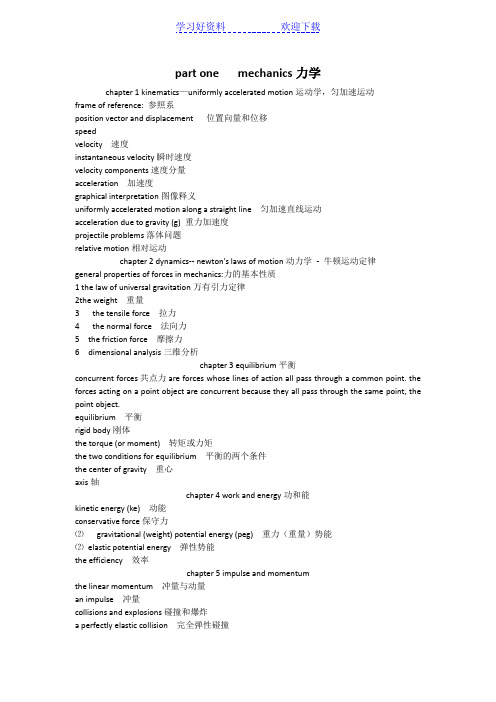
part one mechanics力学chapter 1 kinematics—uniformly accelerated motion运动学,匀加速运动frame of reference: 参照系position vector and displacement 位置向量和位移speedvelocity 速度instantaneous velocity瞬时速度velocity components速度分量acceleration 加速度graphical interpretation图像释义uniformly accelerated motion along a straight line 匀加速直线运动acceleration due to gravity (g) 重力加速度projectile problems落体问题relative motion相对运动chapter 2 dynamics-- newton's laws of motion动力学- 牛顿运动定律general properties of forces in mechanics:力的基本性质1 the law of universal gravitation万有引力定律2the weight 重量3 the tensile force 拉力4 the normal force 法向力5 the friction force 摩擦力6 dimensional analysis三维分析chapter 3 equilibrium平衡concurrent forces共点力are forces whose lines of action all pass through a common point. the forces acting on a point object are concurrent because they all pass through the same point, the point object.equilibrium 平衡rigid body刚体the torque (or moment) 转矩或力矩the two conditions for equilibrium 平衡的两个条件the center of gravity 重心axis轴chapter 4 work and energy功和能kinetic energy (ke) 动能conservative force保守力⑵gravitational (weight) potential energy (peg) 重力(重量)势能⑵elastic potential energy 弹性势能the efficiency 效率chapter 5 impulse and momentumthe linear momentum 冲量与动量an impulse 冲量collisions and explosions碰撞和爆炸a perfectly elastic collision 完全弹性碰撞coefficient of restitution恢复系数the center of mass重心chapter 6 rotation转动the angular speed 角速度the angular acceleration 角加速度tangential 【数】切线;正切centripetal acceleration ( )加速度the centripetal force 向心力chapter 7 rigid-body rotation刚体转动the moment of inertia 转动惯量parallel-axis theorem平行轴定理chapter 8 elasticity弹性elasticity弹性;弹力the stress 【物】应力[u][c]strain 应变the elastic limit弹性极限the shear modulus 切变模量standard atmospheric pressure标准大气压the hydrostatic pressure静水压力equation of continuity连续性方程the viscosity 粘度spring弹簧a restoring force 恢复力simple harmonic motion 简谐运动vibratory motion 振动运动the period ( ) 【数】循环节;周期the frequency ( ) 频率the elastic potential energy 弹性势能the simple pendulum 单摆chapter 11 wave motion波动a propagating wave 波传播wave terminology波术语in-phase vibrations同相振动standing waves驻波conditions for resonance共振的条件longitudinal (compressional) waves 纵向(挤压)波chapter 12 sound声音the intensey (i)强度loudness 响度beats节拍doppler effect 多普勒效应interference effects 干扰效应part two thermodynamics热力学chapter 1 the kinetic theory of gases第1章气体动力学理论avogadro's number ( ) 阿伏伽德罗数()the root mean square speed根均方速度the absolute temperature绝对温度the mean free path (m.f.p.) 平均自由程(m.f.p.)the equipartition theorem of energy 能量均分定理ideal gas law理想气体定律heat 热the internal energy 内部能量an isobaric process is a process carried out at constant pressure. 等压过程是恒压进行的过程。
(完整版)《物理专业英语》.doc
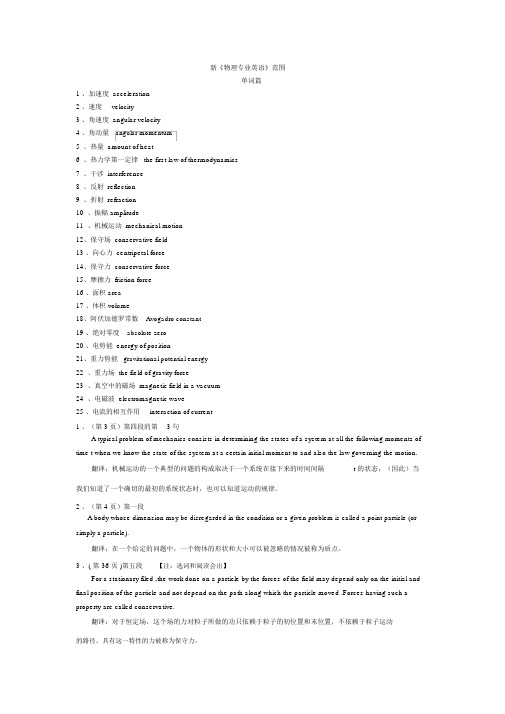
新《物理专业英语》范围单词篇1 、加速度 acceleration2 、速度velocity3 、角速度 angular velocity4 、角动量angular momentum5、热量 amount of heat6、热力学第一定律 the first law of thermodynamics7、干涉 interference8、反射 reflection9、折射 refraction10、振幅 amplitude11、机械运动 mechanical motion12、保守场 conservative field13 、向心力 centripetal force14、保守力 conservative force15、摩擦力 friction force16 、面积 area17 、体积 volume18、阿伏加德罗常数Avogadro constant19 、绝对零度absolute zero20 、电势能 energy of position21、重力势能gravitational potential energy22、重力场 the field of gravity force23、真空中的磁场 magnetic field in a vacuum24、电磁波 electromagnetic wave25 、电流的相互作用interaction of current1 、(第 3 页)第四段的第 3 句A typical problem of mechanics consists in determining the states of a system at all the following moments of time t when we know the state of the system at a certain initial moment to and also the law governing the motion.翻译:机械运动的一个典型的问题的构成取决于一个系统在接下来的时间间隔t 的状态,(因此)当我们知道了一个确切的最初的系统状态时,也可以知道运动的规律。
物理学专业英语A1

物理学专业英 语词汇:提高 学生专业英语
水平
添加 标题
添加 标题
添加 标题
添加 标题
课程目标:培养学 生掌握物理学专业 英语的基本知识和 技能提高英语阅读、 写作和表达能力。
课程内容:涵盖物 理学各个领域的基 本概念、原理和方 法包括力学、热学、 电磁学、光学、原 子物理和量子力学 等方面的英文阅读
光学:研究光的 性质、传播和应 用的科学包括折 射、反射等。
电学:研究电场、 电流和电磁现象 的科学包括欧姆 定律、法拉第电 磁感应等。
热学:研究热量、 温度和物态变化 的科学包括热力 学第一定律、热 力学第二定律等。
牛顿第二定律: F=m
动量守恒定律: p1+p2=p1'+p2'
机械能守恒定律 : E1+E2=E1'+E2'
论文写作是物理学专业英语1课程的重要实践应用之一 学生通过论文写作能够提高英语表达能力和学术写作技巧 论文写作有助于加深对物理学专业知识的理解和掌握 在论文写作过程中学生需要注意学术规范和引用格式的要求
物理学专业英语1课程实践应用:培养学生运用英语进行学术交流的能力包括阅读、写作、听力 和口语等方面的训练。
究中的应用
物理学专业英 语1课程实践应 用:在技术交
流中的应用
物理学专业英 语1课程实践应 用:在国际会
议中的应用
物理学专业英 语1课程实践应 用:在教育领
域中的应用
物理学专业英语1课程的学习目 标是什么?
如何提高物理学专业英语1的阅 读理解能力?
物理学专业英语1课程中常见的 词汇有哪些?
如何有效地记忆和理解物理学 专业英语1中的专业术语?
和写作训练。
物理专业英语
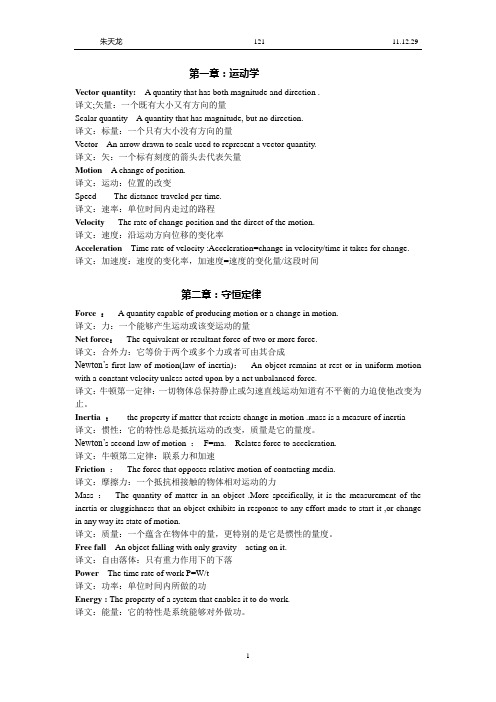
第一章:运动学Vector quantity: A quantity that has both magnitude and direction .译文;矢量:一个既有大小又有方向的量Scalar quantity A quantity that has magnitude, but no direction.译文:标量:一个只有大小没有方向的量Vector An arrow drawn to scale used to represent a vector quantity.译文:矢:一个标有刻度的箭头去代表矢量Motion A change of position.译文:运动:位置的改变Speed The distance traveled per time.译文:速率:单位时间内走过的路程Velocity The rate of change position and the direct of the motion.译文:速度:沿运动方向位移的变化率Acceleration Time rate of velocity :Acceleration=change in velocity/time it takes for change.译文:加速度:速度的变化率,加速度=速度的变化量/这段时间第二章:守恒定律Force : A quantity capable of producing motion or a change in motion.译文:力:一个能够产生运动或该变运动的量Net force:The equivalent or resultant force of two or more force.译文:合外力:它等价于两个或多个力或者可由其合成Newton’s first law of motion(law of inertia):An object remains at rest or in uniform motion with a constant velocity unless acted upon by a net unbalanced force.译文:牛顿第一定律:一切物体总保持静止或匀速直线运动知道有不平衡的力迫使他改变为止。
物理学类专业英语_基础课程
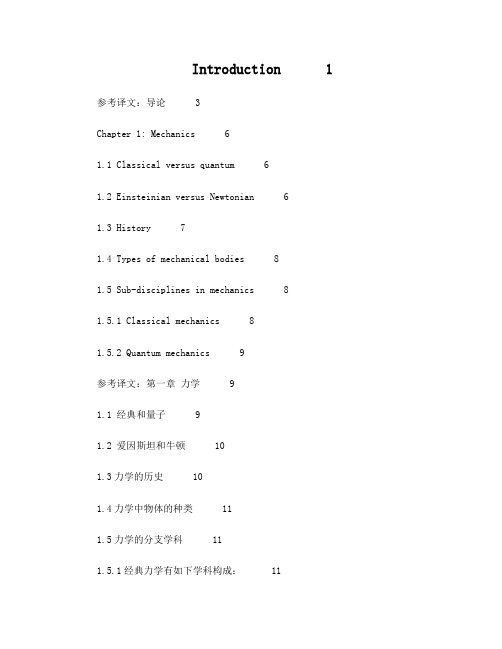
Introduction 1 参考译文:导论 3Chapter 1: Mechanics 61.1 Classical versus quantum 61.2 Einsteinian versus Newtonian 61.3 History 71.4 Types of mechanical bodies 81.5 Sub-disciplines in mechanics 81.5.1 Classical mechanics 81.5.2 Quantum mechanics 9参考译文:第一章力学 91.1 经典和量子 91.2 爱因斯坦和牛顿 101.3力学的历史 101.4力学中物体的种类 111.5力学的分支学科 111.5.1经典力学有如下学科构成: 111.5.2量子力学 12Chapter 2: Heat 132.1 Overview 132.2 Notation 142.3 Definitions 152.4 Thermodynamics 152.4.1 Internal energy 152.4.2 Heat capacity 162.4.3 Phase Changes 172.5 Heat transfer mechanisms 17 2.6 Heat dissipation 19参考译文:第二章热学 202.1 综述 202.2 符号 212.3 定义 212.4 热力学 212.4.1 内能 212.4.2 热容量 222.4.3 相变 232.5 热传递的机制 232.6 散热 24Chapter 3: Electromagnetism 25 3.1 History 253.2 Overview 273.3 Classical electrodynamics 27 3.4 The photoelectric effect 28 3.5 Maxwell's equations 293.6 Special relativity 30参考译文:第三章电磁学 343.1 发展历史 353.2 总论 363.3 经典电动力学 363.4 光电效应 373.5 麦克斯韦方程组 373.6 狭义相对论 37Chapter 4 Optics 414.1 History 414.2 Classical optics 434.2.1 Geometrical optics 44 4.2.2 Physical optics 46 4.3 Modern optics 514.3.1 Lasers 524.3.2 Nonlinear optics 59 参考译文:第四章光学 59 4.1 光学的历史 604.2 经典光学 614.2.1 几何光学 614.2.2 物理光学 634.3 现代光学 664.3.1激光 664.3.2 非线性光学 71Chapter 5 Atomic physics 725.1 Isolated atoms 725.2 Electronic configuration 725.3 History and developments 735.3.1 Introduction to Atomic Physics 74 5.3.2 Atomic Structure 745.3.3 Bohr atom structure model 755.3.4 Atomic Isotopes 765.3.5 Einstein's Equation 765.3.6 Radioactive Decay 77参考译文:第五章原子物理 795.1 孤立原子 795.2 电子图像 795.3 原子物理的历史和发展过程 805.3.1 原子物理引论 805.3.2 原子结构 805.3.3波尔的原子结构模型 815.3.4 原子的同位素 815.3.5 爱因斯坦方程 825.3.6 放射性衰变 82Chapter 6: Quantum mechanics 846.1 Overview 856.2 Quantum mechanics and classical physics 86 6.3 Theory 866.4 Mathematical formulation 89。
(完整版)高中物理专业英语词汇

机械运动mechanical motion [mi'kænikəl] ['məuʃən] 力学mechanics [mɪ'kænɪks]质点mass point [mæs] [pɔint]参考系reference frame ['refrəns] [freim]坐标系coordinate system [kəu'ɔ:dineit] ['sistəm]路程path[pɑ:θ]位移displacement[dɪs'pleɪsmənt]矢量vector['vektə]标量scalar['skeilə]速度velocity[vi'lɔsiti]平均速度average velocity['ævəridʒ] [vi'lɔsiti瞬时速度instantaneous velocity[,ɪnstən'teinjəs]速率speed[spi:d]v-t图象v-t graph[ɡrɑ:f]加速度acceleration [æk,selə'reɪʃən]匀变速直线运动uniformvariablerectilinear motion['ju:nifɔ:m] ['vɛəriəbl] [,rekti'liniə]初速度initial velocity[i'niʃəl] [vi'lɔsiti]自由落体运动free-fall motion自由落体加速free-fall acceleration[æk,selə'reɪʃən]重力加速度gravitational acceleration [,ɡrævi'teiʃnəl]二、物体的相互作用力force[fɔ:s]牛顿Newton['nju:tn]重力gravity['ɡræviti]重心center of gravity['sentə]万有引力gravitation[,grævɪ'teɪʃən]电磁相互electromagnetic interaction[ɪ,lektrəʊmæg'netɪk] 强相互作用strong interaction[,ɪntər'ækʃən]弱相互作用weak interaction形变deformation[,di:fɔ:'meɪʃən,]弹性形变elastic deformation[i'læstik] [,di:fɔ:'meɪʃən,]弹性限度elastic limit[i'læstik] ['limit]弹力elastic force[i'læstik] [fɔ:s]劲度系数coefficient of stiffness[,kəʊə'fɪʃənt] ['stɪfnɪs]胡克定律Hooke law[lɔ:]摩擦力friction force['frikʃən]静摩擦力static frictional force['stætik] ['frikʃən]滑动摩擦力sliding frictional force['slaidiŋ]动摩擦因数dynamic friction factor[dai'næmik]合力resultant force[ri'zʌltənt]分力component force[kəm'pəunənt]力的合成composition of forces[,kɔmpə'ziʃən]三角形定则triangularrule[traɪ'æŋgjələ] [ru:l]三、牛顿运动定律运动学kinematics[kini'mætiks]动力学dynamics[dai'næmiks]牛顿第一定律Newton first law['nju:tn] [lɔ:]惯性inertia [i'nə:ʃjə]惯性定律law of inertia[i'nə:ʃjə]质量mass[mæs]惯性系inertial system['sistəm]牛顿第二定律Newton second law单位制system of units国际单位制Le System International d’Unites作用力action['ækʃən]反作用力reaction[ri'ækʃən]牛顿第三定律Newton third law超重overweight[,əʊvə'weɪt]失重weightlessness['weɪtlɪs]误差error['erə]偶然误差accidental error[,æksi'dentl]系统误差systematic error [,sistə'mætik]绝对误差absolute error['æbsəlu:t]相对误差relative error['relətiv]四、圆周运动曲线运动curvilinear motion[kə:vi'liniə]切线tangent['tændʒənt]抛体运动projectile motion[prə'dʒektəl,]抛物线parabola[pə'ræbələ]线速度linear velocity['liniə]匀速圆周运动uniformcircularmotion['ju:nifɔ:m]['sə:kjulə]角速度angular velocity['æŋgjələ]弧度radian['reidjən]周期period['piəriəd]向心加速度centripetal acceleration[sen'trɪpɪtl]向心力centripetalforce[sen'trɪpɪtl]开普勒Kepler引力常量gravitational constant [,ɡrævi'teiʃnəl] ['kɔnstənt]万有引力定律law of universal gravitation[,ju:ni'və:səl]第一宇宙速度first cosmic velocity['kɔzmik]第二宇宙速度second cosmic velocity第三宇宙速度third cosmic velocity能量energy['enədʒi]势能potential energy[pə'tenʃəl]动能kinetic energy[kɪ'netɪk, kaɪ-]功work[wə:k]焦耳joule[dʒu:l]功率power['pauə]瓦特watt['pauə]重力势能gravitational potential energy [,ɡrævi'teiʃnəl] [pə'tenʃəl]弹性势能elastic potential energy[i'læstik] [pə'tenʃəl]动能定理theorem of kinetic energy['θi:ərəm] [kɪ'netɪk]机械能mechanical energy[mi'kænikəl]机械能守恒定律law of conservation of mechanical energy[,kɔnsə'veiʃən] [mi'kænikəl]能量守恒定律law of energy conservation[,kɔnsə'veiʃən]拉力traction['trækʃən]轨道obital大小magnatitude方向direction[di'rekʃən]水平horizental竖直vertical['və:tikəl]相互垂直perpendicular[,pɜ:pən'dɪkjələ]坐标coordinate[kəu'ɔ:dineit]直角坐标系cersian coordinate system弹簧spring[spriŋ]球体sphere[sfiə]环loop[lu:p]盘型disc圆柱形cylinder['silində]。
物理专业英语-课件
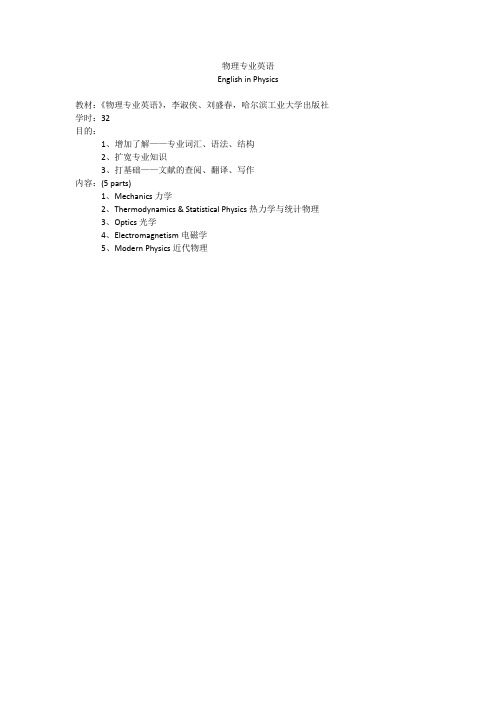
物理专业英语English in Physics教材:《物理专业英语》,李淑侠、刘盛春,哈尔滨工业大学出版社学时:32目的:1、增加了解——专业词汇、语法、结构2、扩宽专业知识3、打基础——文献的查阅、翻译、写作内容:(5 parts)1、Mechanics力学2、Thermodynamics & Statistical Physics热力学与统计物理3、Optics光学4、Electromagnetism电磁学5、Modern Physics近代物理Part 1 The physical fundamentals of mechanicsCharpter1 kinematics§1-0 Prologuequestions:Can you briefly describe mechanics in your mind?Study the motion of the material bodiesHave long historyTremendous growth by Galileo and NewtonWhat can we do applying the principles of mechanics?Predict motions \ analyse motions and explain the causeWhy mechanics is most important branch of physics?The first complete branch,furnish the basic concepts of whole physics, influence theother branches.passages:✧Now we apply some principles to the motions of artificial satellites such as anorbiting Space Shuttle. In general, the principles of mechanics can be applied toi. The motions of celestial objects so as to accurately predict events, in somecases many years before they happen, for example, the return of the Halley’scomet;ii. The motions of ordinary objects on Earth , for example, an automobile or a thrown baseball;iii. The behavior of atoms, atomic particles, and subatomic particles, withconsiderable success.words:●kinematics[,kini'mætiks, kai]n. the branch of mechanics concerned with motion withoutreference to force or mass运动学;动力学●celestial [si'lestjəl] adj. adj.1. of or relating to the sky 2. relating to or inhabiting a divine heaven 3.of heaven or the spirit 天上的,天空的●space shuttle n. a reusable spacecraft with wings for a controlled descent through the Earth'satmosphere太空飞船●comet ['kɔmit] n. (astronomy) a relatively small extraterrestrial body consisting of a frozen massthat travels around the sun in a highly elliptical orbit●differentiate [,difə'renʃieit] v. 1. mark as different 2. be a distinctive feature, attribute, or trait;sometimes in a very positive sense 3. calculate a derivative; take the derivative4. becomedifferent during development cells differentiate 5. evolve so as to lead to a new species or develop in a way most suited to the environment 6. become distinct and acquire a different charactervi. 区分,区别vt. 区分,区别§1-1Mechanical motionquestions:●What must we introduce or consider when we describe the mechanical motion?●Why do we usually study the idea models, such as particle and rigid body?●When a body we study is regarded as a point particle ? or a rigid body?●How can we describe the motion of a body or system ?●How many kinds of the motion of the rigid body? And what they are?●Can you describe the Cartesian coordinates as a example in this section?Passage:✧It was indicated above that motion in mechanics is defined as the change in themutual arrangement of the bodies. If we imagine a separate isolated body in aspace where no others are present, then we cannot speak of the motion of thebody because there is nothing with respect to which the body could change its position. It thus follows that if we intend to study the motion of a body, then we must indicate with respect to what other bodies the given motion occurs.✧To describe the motion of a body means to indicate for every moment of thetime the position of the body in space and its velocity. To set the state of amechanical system, we must indicate the positions and the velocities of all thebodies forming the system. A typical problem of mechanics consists indetermining the states of a system at all the following moments of time t whenwe know the state of the system at a certain initial moment t0 and also the laws governing the motion.✧It is simpler to treat a point particle than an extended body. We shall thereforefirst study the mechanics of a particle, and then go over to the mechanics of arigid body. We shall start with kinematics, and then delve into dynamics. Weremind our reader that kinematics studies the motion of bodies without regardto what causes this motion. Dynamics studies the motion of bodies with a view to what causes this motion to have the nature it does, i.e. with a view to theinteractions between bodies.Word:timepiece ['taimpi:s] n. a measuring instrument or device for keeping time 计时器stationary ['steiʃənəri] adj. 1. standing still 2. not capable of being moved 固定的;静止的;定居的;常备军的reference frame n. a system that uses coordinates to establish position参考系,参考坐标系constant ['kɔnstənt]adj. 1. persistent in occurrence and unvarying in nature 2. continually recurring or continuing without interruption 3. steadfast in purpose or devotion or affection 4.uninterrupted in time and indefinitely long continuing n.1. a quantity that does not vary2. anumber representing a quantity adj. 不变的;恒定的;经常的n. [数] 常数;恒量corridor ['kɔridɔ:] n. an enclosed passageway; rooms usually open onto it走廊disengage [,disin'ɡeidʒ] v. release from something that holds fast, connects, or entangles 使脱离;解开;解除disengage from 使…从…脱离(或解脱、解除):deform [di'fɔ:m] v. 1. make formless 2. twist and press out of shape 3. cause (a plastic object) to assume a crooked or angular form 4. become misshapen 5. alter the shape of(something) by stress 6. assume a different shape or form vt. 使变形;使成畸形vi. 变形;变畸形adj. 畸形的;丑陋的Cartesian [kɑ:'tiziən] adj. of or relating to Rene Descartes or his works adj. 笛卡尔哲学的;笛卡尔的cartesian coordinate [数学]笛卡尔坐标cartesian coordinate system 笛卡儿坐标系统cartesian product 笛卡儿积cartesian space 直角坐标空间;欧几里得空间;笛卡儿空间rectangular ['rek'tæŋɡjulə] adj. 1. having four right angles 2. having a set of mutually perpendicular axes; meeting at right angles adj. 矩形的;成直角的lattice ['lætis] n. 1. an arrangement of points or particles or objects in a regular periodic pattern in 2 or 3 dimensions 2. small opening (like a window in a door) through which business can be transacted 3. framework consisting of an ornamental design made of strips of wood or metal[晶体] 晶格;格子;格架rod [rɔd] n. 1. a linear measure of 16.5 feet 2. a long thin implement made of metal or wood3. any rod-shaped bacterium4. a square rod of land5. visual receptor cell sensitive to dimlight 6. a gangster's pistol 棒;惩罚;枝条;权力identical [ai'dentikəl]adj. 同一的;完全相同的n. 完全相同的事物scale1 [skeil] n.1. an ordered reference standard 2. relative magnitude 3. the ratio between the size of something and a representation of it v.1. measure by or as if by a scale 2. pattern, make, regulate, set, measure, or estimate according to some rate or standard3. take by attacking withscaling ladders 4. reach the highest point of 5. measure with or as if with scales 6. size or measure according to a scale n.规模;比例;鳞;刻度;天平;数值范围v. 测量;依比例决定graduate ['ɡrædʒuət, 'ɡrædjueit] v 1. receive an academic degree upon completion of one's studies 2. make fine adjustments or divide into marked intervals for optimal measuringvt. 授予…学位;分等级;标上刻度synchronize ['siŋkrənaiz] v.1. make synchronous and adjust in time or manner 2. happen at the same time3. make (motion picture sound) exactly simultaneous with the action 4. arrange orrepresent events so that they co-occur 5. operate simultaneously 6. cause to indicate the same time or rate vt. 使……合拍;使……同步vi. 同步;同时发生go over 复习,重温;仔细检查;转变;润色delve [delv] v. turn up, loosen, or remove earthvi. 钻研;探究;挖i.e. 是拉丁文id est [id'est]的缩写,它的意思就是“那就是说,换句话说”,等同于“thatis,in other words” ,目的是用来进一步解释前面所说的观点。
(完整word版)物理专业英语复习题库
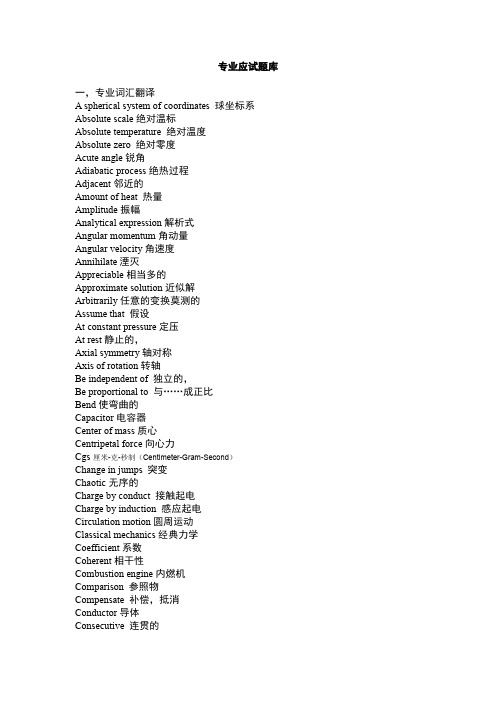
专业应试题库一,专业词汇翻译A spherical system of coordinates 球坐标系Absolute scale绝对温标Absolute temperature 绝对温度Absolute zero 绝对零度Acute angle锐角Adiabatic process绝热过程Adjacent邻近的Amount of heat 热量Amplitude振幅Analytical expression解析式Angular momentum角动量Angular velocity角速度Annihilate湮灭Appreciable相当多的Approximate solution近似解Arbitrarily任意的变换莫测的Assume that 假设At constant pressure定压At rest静止的,Axial symmetry轴对称Axis of rotation转轴Be independent of 独立的,Be proportional to 与……成正比Bend使弯曲的Capacitor电容器Center of mass质心Centripetal force向心力Cgs厘米-克-秒制(Centimeter-Gram-Second)Change in jumps 突变Chaotic无序的Charge by conduct 接触起电Charge by induction 感应起电Circulation motion圆周运动Classical mechanics经典力学Coefficient系数Coherent相干性Combustion engine内燃机Comparison 参照物Compensate 补偿,抵消Conductor导体Consecutive 连贯的Consequently结果,因此Conservation守恒Considerable 相当大的Constant常量Constructive interference 干涉相长Coordinate system坐标系Coulomb’s law库仑定律Counter-phase反相Cross-sectional 横截面Curl旋度Curvilinear motion曲线运动Cyclic process循环过程Decrement衰减率Denominator分母Density密度Derivative导数Destructive interference干涉相消Developing显影Deviation from脱离逸出Diatomic双原子的Difference差异Diffraction衍射Dimension 维Discrete value离散值Displacement位移Distance 距离Distribution function分布函数Divergence 散度Dynamics动力学Elastic collision弹性碰撞Electric dipole电偶极子Electric field 电场Electric potential 电势Electric potential energy电势能Electrically polarized电极化Electrodynamics电动力学Electromagnetic电磁学Electron电子Electrostatic静电Elementary mass元质量,质量元Embodiment体现具体化Emulsion感光剂Energy能量Energy level 能级Entropy 熵Equilibrium平衡Equipartition principle均分定理Ether以太Exposure曝光External force外力Factor因素First law of thermodynamics热力学第一定律Focal plane焦平面Fraunhofer diffraction夫琅和费衍射Free fall自由落体Friction摩擦力Gamma photon伽马射线General theory relativity广义相对论Geometrical几何的Gradient梯度Gravity重力,地心引力Grow proportionally to 正比增长Harmonic function调和函数Harmonic oscillator谐振子Heat 热Heat capacity 热容Heat engine热机Heat transfer热传递Hence因此Histogram直方图Hologram 全息图Holography 全系照相Homogeneous(反应堆)燃烧和减速剂均匀调和的Huygens’ Principle惠更斯原理Hypothetical medium 假设介质Ideal gass理想气体Identical 同一的,完全相同的Illuminate说明Impart 给予Impulse冲量Inalienable不可分割的Incident light入射光Inclination倾角Incoherene非相干的Increase增加Increment增量Inertia惯性Inertial reference frame惯性参考系Infrared radiation 红外辐射Initial moment 初始时刻Instantaneous瞬间的Insulator 绝缘体Integral 积分Interference 干涉Internal energy 内能Internal force内力Intra-molecular energy 分子内能Isotropic 各向同性的Kinematics运动学Law of cosine square余弦定理Length contraction长度收缩Macroscopic宏观的Mass质量Mass-energy conversion质能转换Mean distance 平均距离Mechanical equivalent of heat热功当量Mechanics力学Medium 介质Microscopic 微观的Molar heat gas capacity 气体摩尔热容Mole 摩尔Molecular physics分子物理学Momentum动量Monatomic单原子Monochromatic light单色光Motion运动Multiply乘以Neutron中子Newton’s first law牛顿第一定律Non-equilibrium state非平衡态Normal acceleration法向加速度Normal to 垂直于Nuclei原子核Nucleon 核子Numerator 分子Object beam 物体光束Obtuse angle钝角Operator算符Overlap 重叠Polarization两极分化极化Parallel axis theorem平行轴定理Parallel beams平行光束Parallel rays平行光Parallelogram method平行四边形法则Parameter of state状态参数Perfectly rigid body刚体Perpendicular垂直的Phase difference相位差Phenomena现象Piston活塞Point charge点电荷Point particle质点Power功率Preference优先权Principle of relativity相对性原理Probability可能性Probability distribution function概率分布函数Projection 投影Propagate传播Proton质子Pseudoscopic幻视镜的Quantitative conclusion定量结论Quasi-static 准静态的Radian弧度Radius半径Rarefaction稀薄的Real image实像Rectilinear motion 直线运动Redistribution重新分配Reference frame参考系Reference wave参考波Relative atomic mass of an element相对原子质量Relative molecular mass of substance相对分子质量Relaxation process弛豫过程Relaxation time 弛豫时间Reversible (process)可逆过程Rotational inertia转动惯量Scalar标量Scalar field标量场Semiconductor半导体Semitransparent 半透明的Solid angle立体角Spatial coherence 空间相干性Special theory of relativity狭义相对论Specific heat capacity 比热容Speed 速度速率Stationary 固定的Subscript下标Superpose 重叠的Superposition叠加Symmetry对称的Temperature温度Temporal coherence 时间相干性Terminal velocity末速度Test charge检验电荷The difference on optical path 光程差The equation of state of an ideal gass理想气体物态方程The magnitude of a vector向量的大小The number of degree of freedom自由度数量The reciprocal of 倒数The refractive index折射率The right-hand screw rule右手螺旋定则The second derivative of 二阶导数The square of distance距离的平方The tangential acceleration切向加速度Thermodynamic temperature scale热力学温标Three dimensional三维的Time averaged value时间均值Time dilation时间膨胀Timepiece计时器Torque力矩Torsion balance扭秤Translation motion平动Triatomic三原子的Tuning fork音叉Twin paradox孪生佯谬Ultraviolet light紫外线Undeformable body不可形变体,刚体Uniform circular motion匀速圆周运动Unit time单位时间Vector field 矢量场Vectors矢量Velocity 速度,矢量Virtual image虚像Wave length 波长Wave number波数Weight重量)二、段落翻译翻译('541、For a stationary field, the work done on a particle by the forces of the field may depend on theinitial and final position of the particle and not depend on the path along which the particle moved. Forces having such a property are called conservative.对于固定的场,力作用在质点上的公取决于初始位置和末位置,而与路径无关,具有这个性质的力叫保守力.2、 A combination of bodies that are stationary relative to one another with respect to whichmotion is being considered an a timepiece indicating the time forms a reference frame.由运动上相对静止的物体所组成的复合体,外加显示(记录)时间的仪器,一起构成了参考系统。
- 1、下载文档前请自行甄别文档内容的完整性,平台不提供额外的编辑、内容补充、找答案等附加服务。
- 2、"仅部分预览"的文档,不可在线预览部分如存在完整性等问题,可反馈申请退款(可完整预览的文档不适用该条件!)。
- 3、如文档侵犯您的权益,请联系客服反馈,我们会尽快为您处理(人工客服工作时间:9:00-18:30)。
新《物理专业英语》范围单词篇1 、加速度acceleration2 、速度 velocity3 、角速度 angular velocity4 、角动量angular momentum5 、热量 amount of heat6 、热力学第一定律 the first law of thermodynamics7 、干涉 interference8 、反射 reflection9 、折射 refraction10 、振幅 amplitude11 、机械运动 mechanical motion12、保守场 conservative field13 、向心力 centripetal force14、保守力 conservative force15、摩擦力 friction force16 、面积area17 、体积 volume18、阿伏加德罗常数 Avogadro constant19 、绝对零度 absolute zero20 、电势能 energy of position21、重力势能 gravitational potential energy22 、重力场 the field of gravity force23 、真空中的磁场 magnetic field in a vacuum24 、电磁波 electromagnetic wave25 、电流的相互作用interaction of current1、(第3页)第四段的第3句A typical problem of mechanics consists in determining the states of a system at all the following moments of time t when we know the state of the system at a certain initial moment to and also the law governing the motion.翻译:机械运动的一个典型的问题的构成取决于一个系统在接下来的时间间隔t的状态,(因此)当我们知道了一个确切的最初的系统状态时,也可以知道运动的规律。
2、(第4页)第一段A body whose dimension may be disregarded in the condition or a given problem is called a point particle (or simply a particle).翻译:在一个给定的问题中,一个物体的形状和大小可以被忽略的情况被称为质点。
3、(第36页)第五段【注:选词和阅读会出】For a stationary filed ,the work done on a particle by the forces of the field may depend only on the initial and final position of the particle and not depend on the path along which the particle moved .Forces having such a property are called conservative.翻译:对于恒定场,这个场的力对粒子所做的功只依赖于粒子的初位置和末位置,不依赖于粒子运动的路径。
具有这一特性的力被称为保守力。
4、(第40页)第一行A field of forces is called potential if it can be described with the aid of the function V(x,y,z,t), whose gradient [see the following section, Eq.(2.13)] determines the force at each point of the field:F=∇V [compare with Eq.(2.32)].the function V is called the potential function or the potential.翻译:一个力场被称为势场,如果可以借助函数V(x,y,z,t)来描述,[看下一部分,E.q.(2.31)]它的梯度决定力场中的每一个点:F=∇V[与(2.32)比较]。
函数V被称为势函数或势场。
5、(第56页)第二段和第三段【注:翻译、选词、阅读会出】In translation,all the points of a body receive displacements equal in magnitude and direction during the same time interval .Consequently, the velocities and accelerations of all the points are identical at every moment of time .It is therefore sufficient (足够的;充分的)to determine the motion of one of the points of a body (for example ,of its center of mass) to completely characterize the motion of the entire body.翻译:在平动中,刚体上所有的点在相同的时间间隔内得到大小和方向都相同的位移。
因此,所以的点的速度和加速度在各个时刻是相同的。
因此充分的取决于用刚体上一点(例如,质心)的运动来完全描述整个刚体的运动特征。
In rotation,all the points of a rigid move along circles whose centers are on a single straight line called the axis of rotation.To describe rotation,we must set the position of the axis of rotation in space and the angular velocity of the body at each moment of time .翻译:在转动中,刚体上所有的点沿着圆周运动的中心在一条单直线上被称为旋转轴。
为了描述转动,我们必须设定空间中旋转轴的位置和刚体在各个时刻的角速度。
6、(第79页)第一段和第二段The masses of atoms and molecules are characterized by(通过...来区分)using quantities known as the relative atomic mass of an element (the atomic mass in short) and the relative molecular mass of substance (the molecular mass).翻译:原子和分子的质量通过使用质量来区分被称为元素的相对原子质量(简称原子质量)和物质的相对分子质量(简称分子质量)。
the atomic mass (Ar)of a chemical element is defined as the ratio of the mass of an atom of the element to12(This is the symbol for the carbon isotope with a mass number of 12) .The1/12 of the mass of the atom Cmolecular mass (Mr) of a substance is defined as the ratio of the mass of a molecule of the substance to 1/12 of the12. Their definitions show that the atomic and molecular masses are dimensionlessmass of the atom CQuantities .翻译:一种化学元素的相对原子质量被定义为这种元素的原子的质量与C 12原子的质量的1/12 的比值。
物质的相对分子质量被定义为物质的分子的质量与C 12原子的质量的1/12 的比值。
它们的定义表明原子和分子的质量是无量纲的。
7、(第85页)第一段、第二段和第三段 The internal energy can change in the main at the expense of two different processes:the performance of the work A' on a body and the imparting of the heat Q to it.The doing of work is attended by the displacement of the external bodies acting on the system .For example ,when we move in the piston closing a vessel with a gas ,the piston when moving does the work A' on the gas . According to Newton ’s law,the gas, in turn ,dose the work A = -A' on the piston .翻译:内能可以交换总的来说是两个不同过程的(能量的)损失:一个物体所做的功A'和物体传递的热量Q 。
所做的功是由外界物体对系统做功的增量决定的。
例如,当我们移动充满气体的密闭容器的活塞的时候,移动时活塞对气体做的功为A' 。
根据牛顿第三定律,总的来说,气体对活塞做的功为 A=-A'。
The imparting of heat to a gas is not associated with the motion of external bodies and is therefore not associated with the doing of macroscopic (i.e. relating to the entire complex of molecules which the body consists of ) work on the gas .In this case,the change in the internal energy is due to the fact that separate molecules of the hotter body do work on separate molecules of the colder one .Energy is also transferred here by radiation.The combination of microscopic (i.e. involving not an entire body ,but separate molecules of it ) processes is called heat transfer.翻译:气体热量的传递不与外界物体的运动相联系也因此不与宏观上对气体作功相联系。
